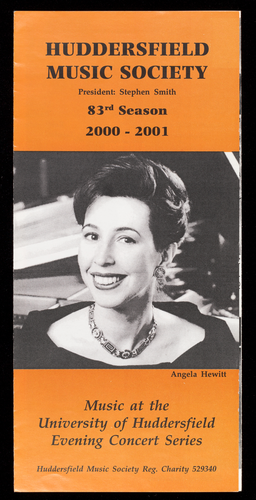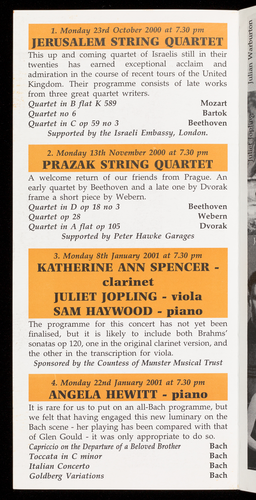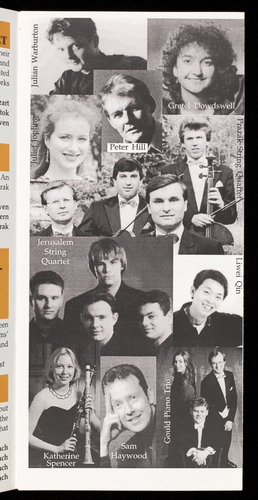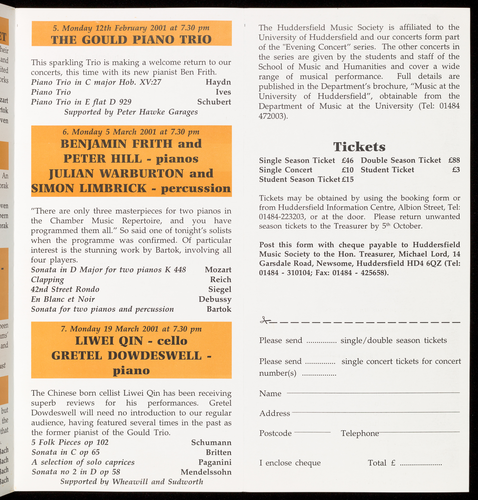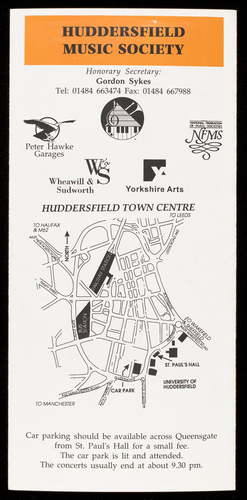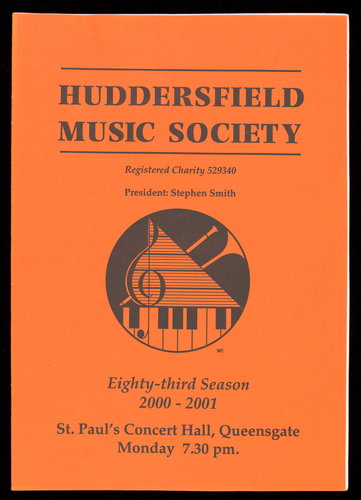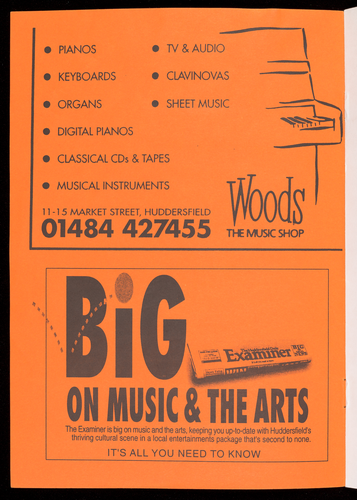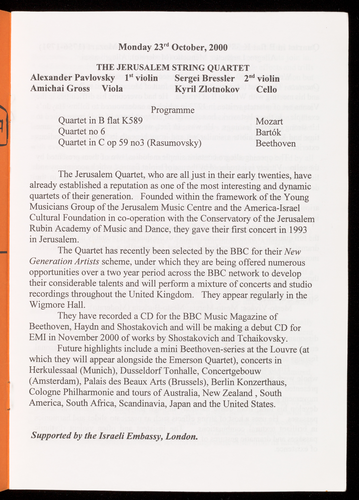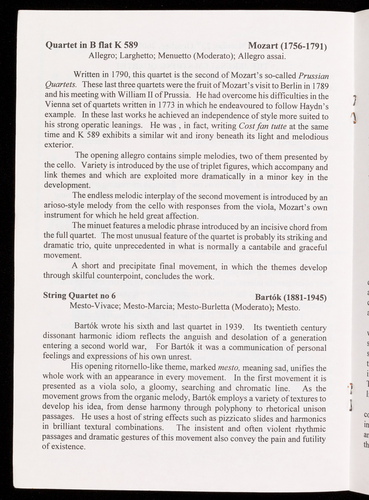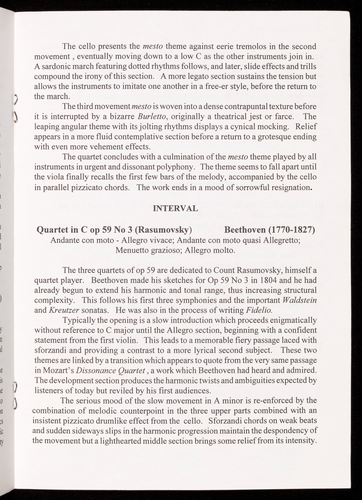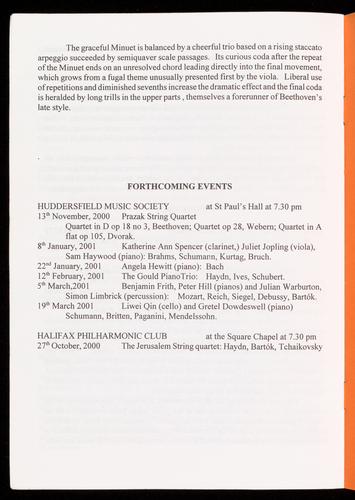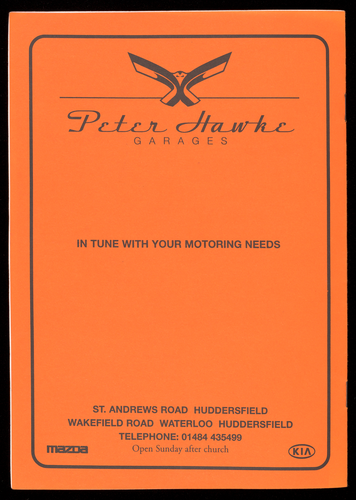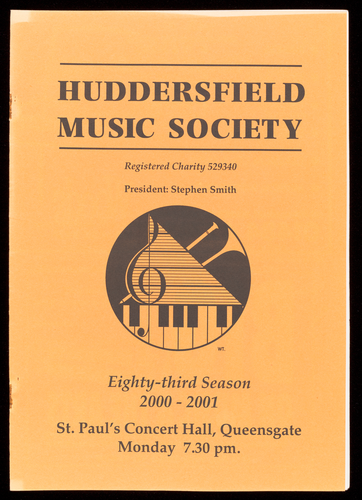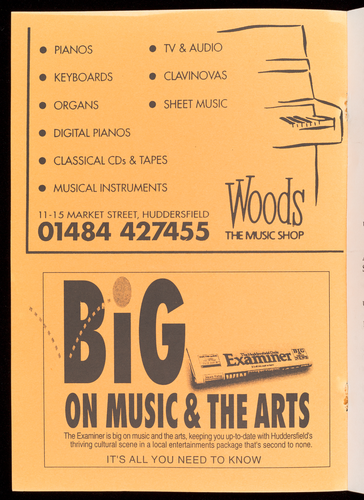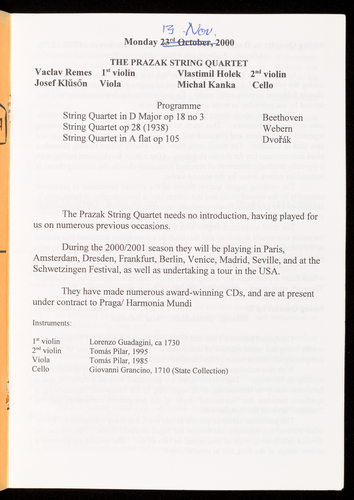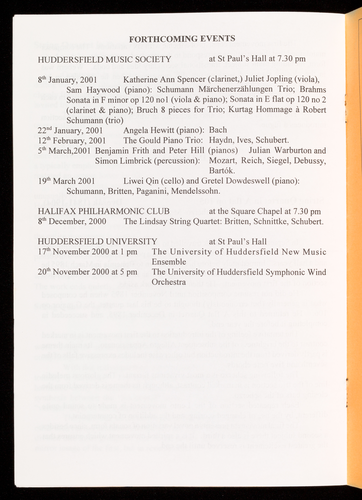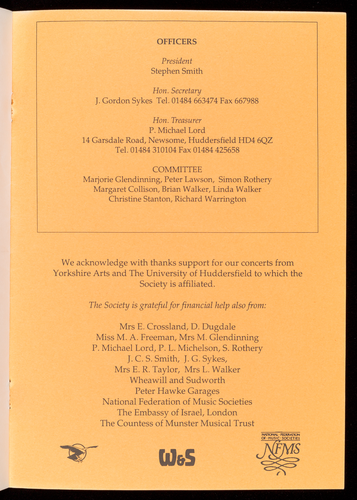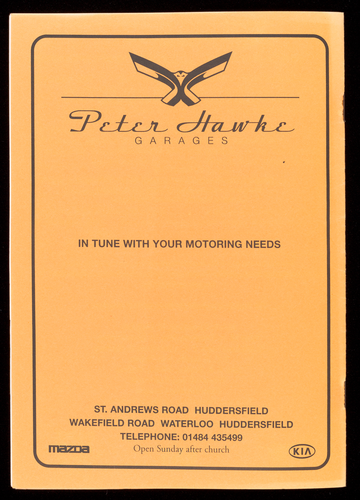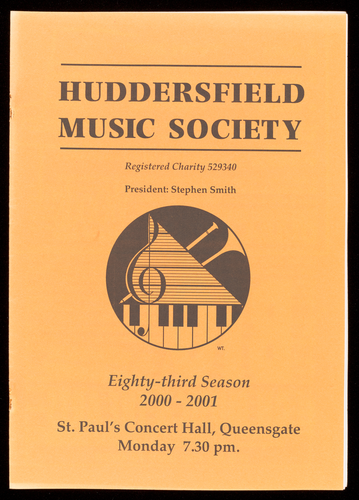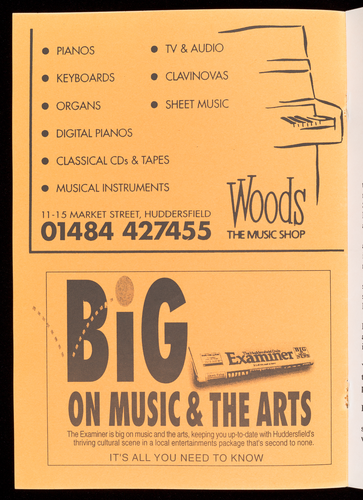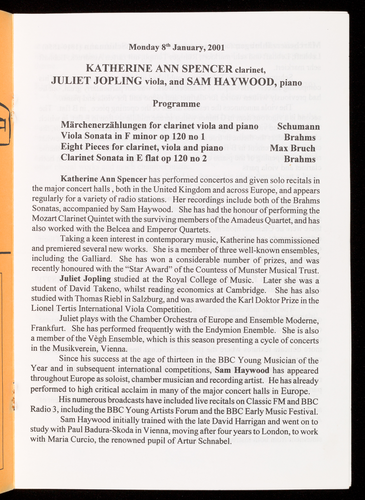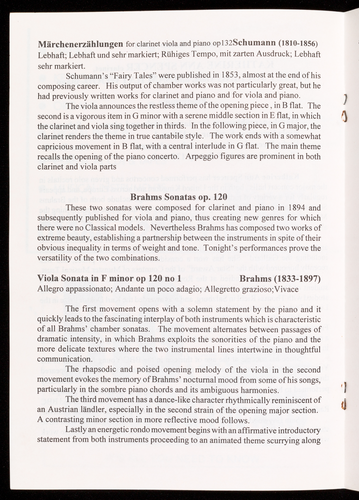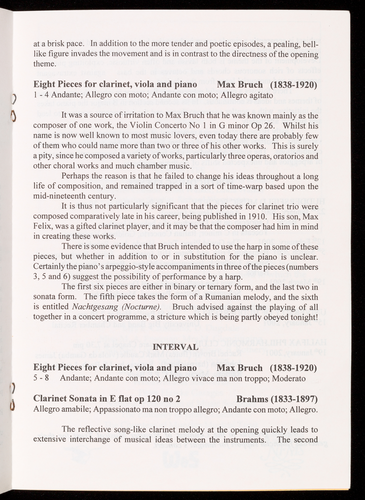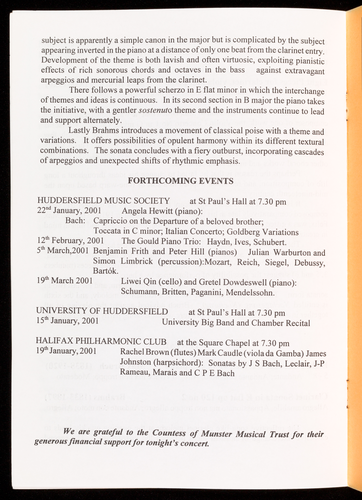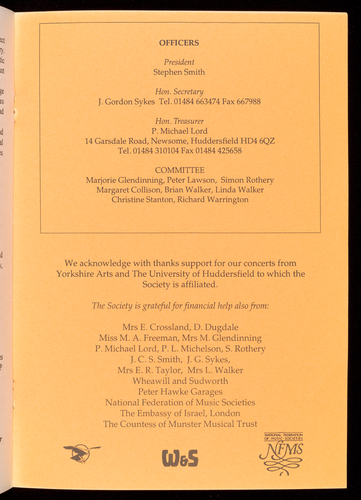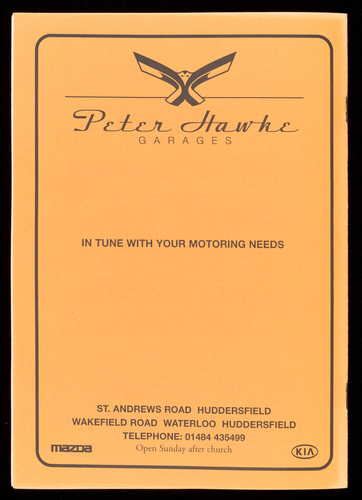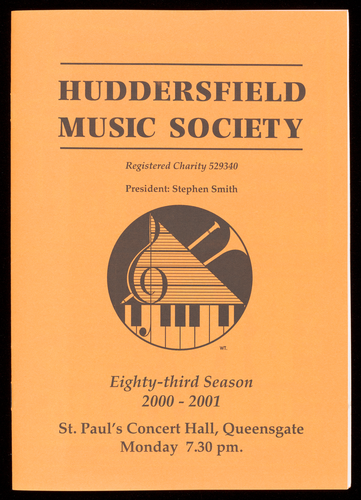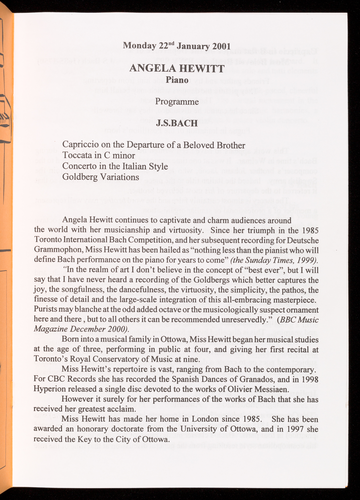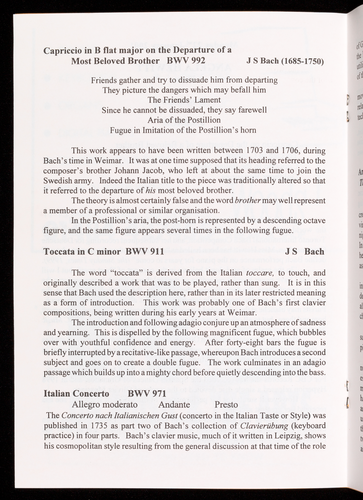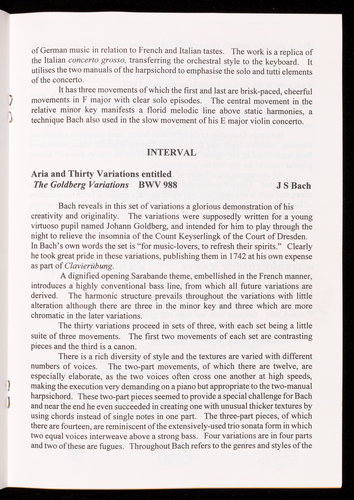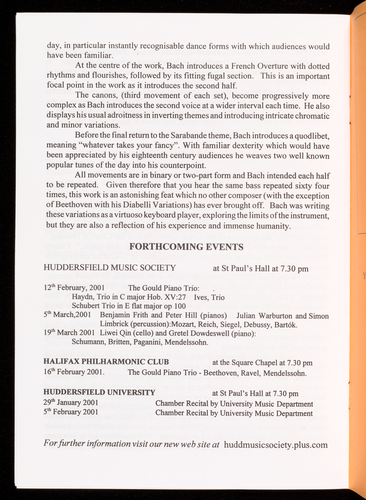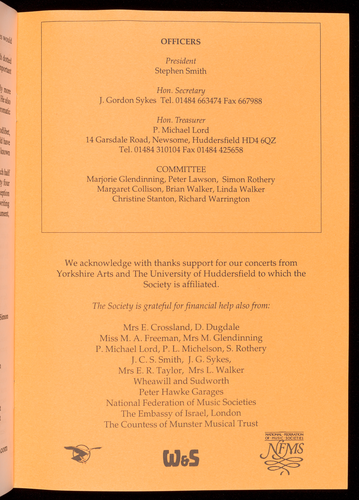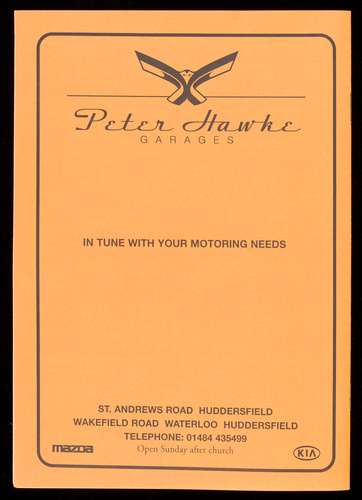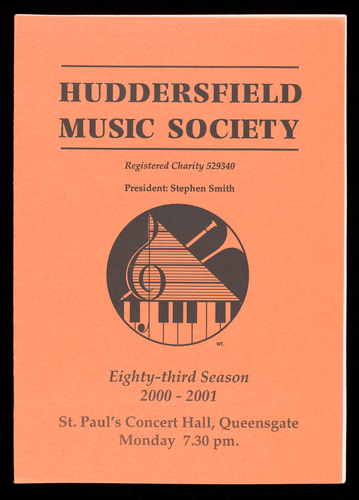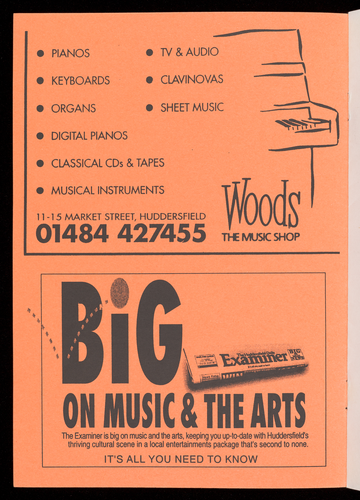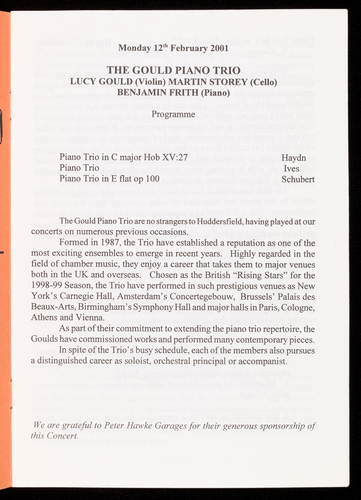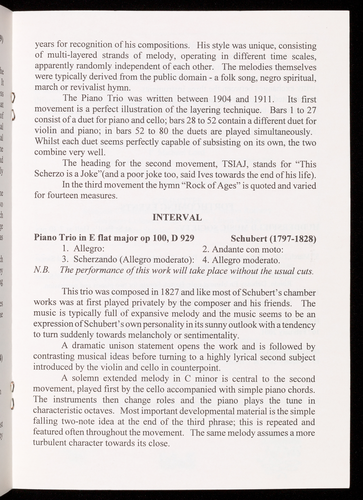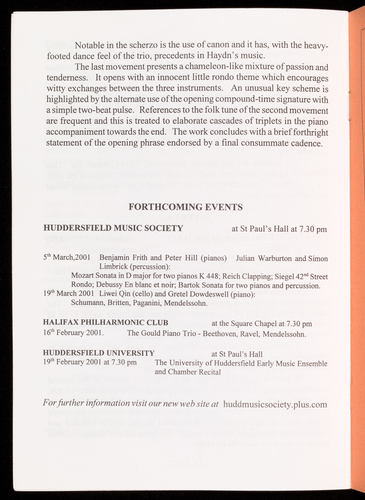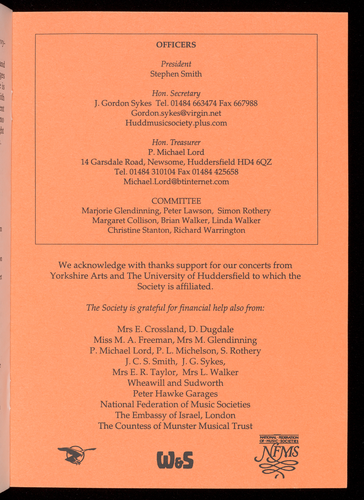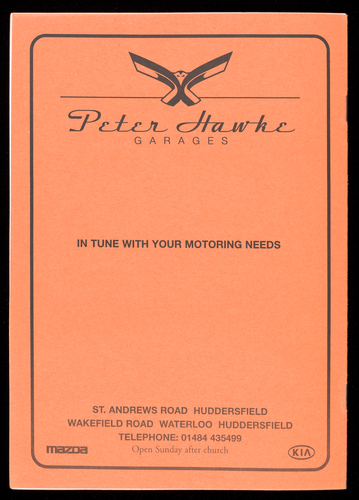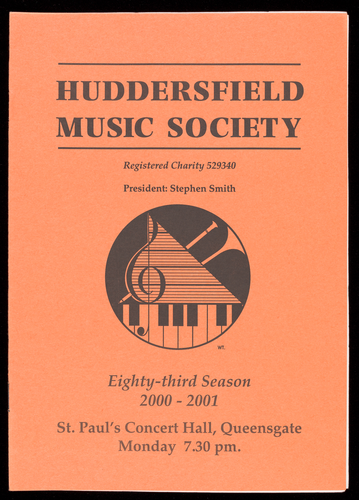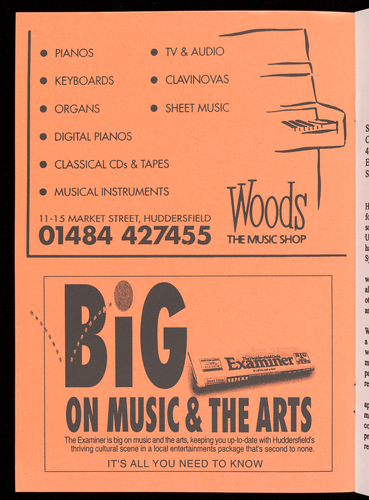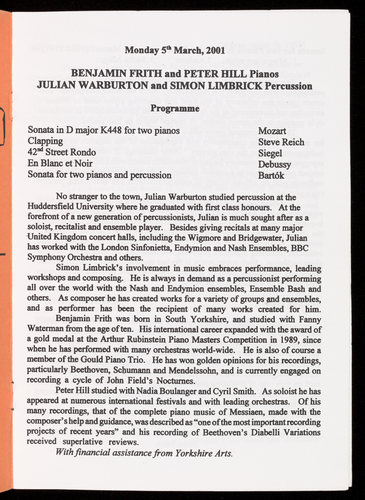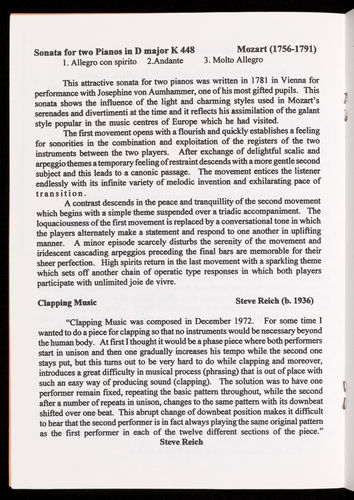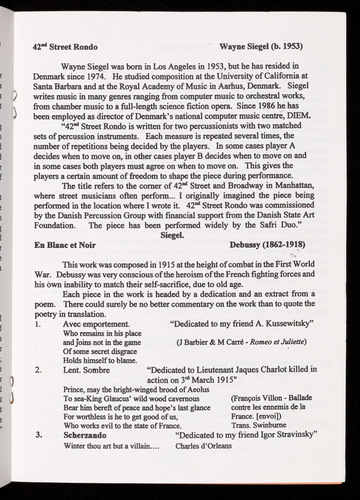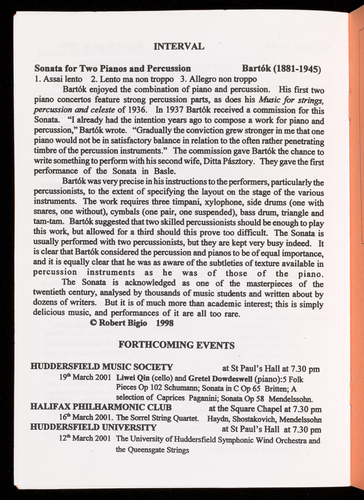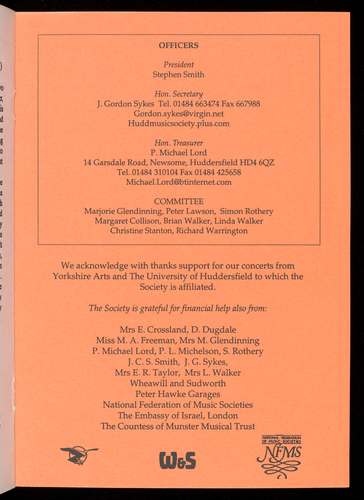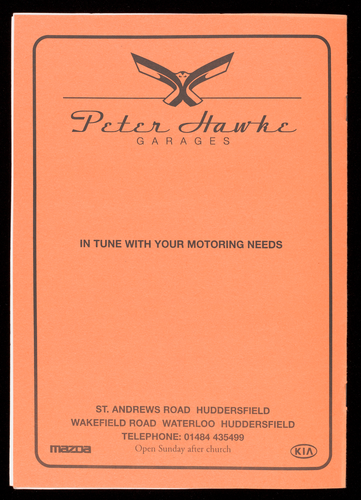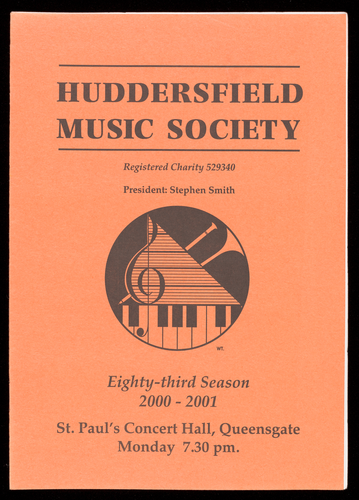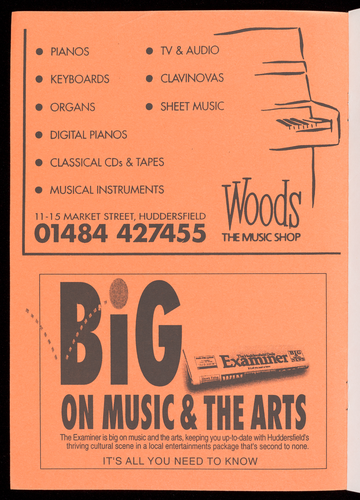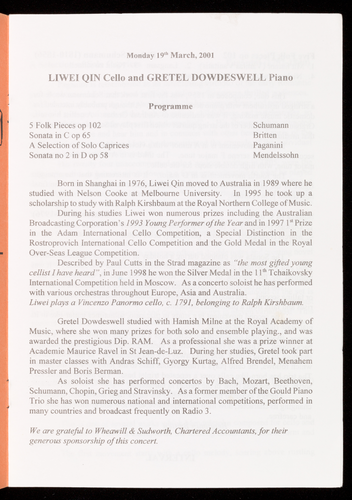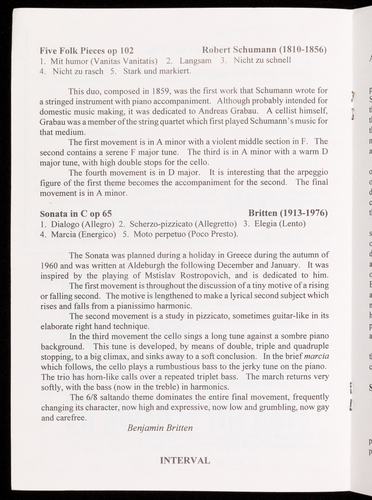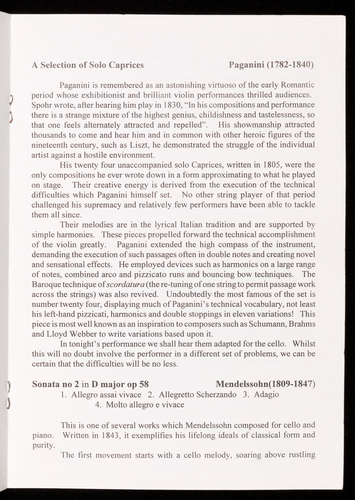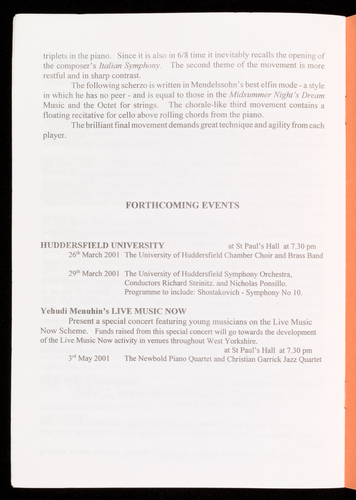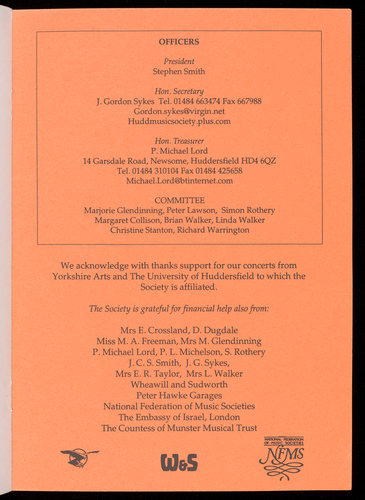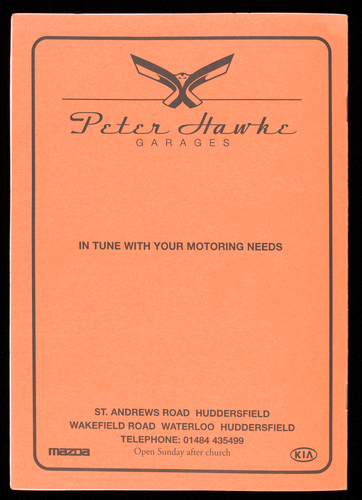Ocr'd Text:
HUDDERSFIELD
MUSIC SOCIETY
President: Stephen Smith
83rd Season
2000-2001
Angela Hewitt
Music at the
University of Huddersfield
Evening Concert Series
Huddersfield Music Society Reg. Charity 529340
Ocr'd Text:
1. Monday 23rd October 2000 at 7.30 pm
JERUSALEM STRING QUARTET
This up and coming quartet of Israelis still in their
twenties has earned exceptional acclaim and
admiration in the course of recent tours of the United
Kingdom. Their programme consists of late works
from three great quartet writers.
Quartet in B flat K 589
Quartet no 6
Quartet in C op 59 no 3
Mozart
Bartok
Beethoven
Supported by the Israeli Embassy, London.
2. Monday 13th November 2000 at 7.30 pm
PRAZAK STRING QUARTET
A welcome return of our friends from Prague. An
early quartet by Beethoven and a late one by Dvorak
frame a short piece by Webern.
Quartet in D op 18 no 3
Quartet op 28
Quartet in A flat op 105
Beethoven
Webern
Dvorak
Supported by Peter Hawke Garages
3. Monday 8th January 2001 at 7.30 pm
KATHERINE ANN SPENCER-
clarinet
JULIET JOPLING - viola
SAM HAYWOOD - piano
The programme for this concert has not yet been
finalised, but it is likely to include both Brahms'
sonatas op 120, one in the original clarinet version, and
the other in the transcription for viola.
Sponsored by the Countess of Munster Musical Trust
4. Monday 22nd January 2001 at 7.30 pm
ANGELA HEWITT - piano
It is rare for us to put on an all-Bach programme, but
we felt that having engaged this new luminary on the
Bach scene - her playing has been compared with that
of Glen Gould - it was only appropriate to do so.
Capriccio on the Departure of a Beloved Brother
Toccata in C minor
Italian Concerto
Goldberg Variations
Bach
Bach
Bach
Bach
Julian Warburton
Juliet Jopling
Ocr'd Text:
T
meir
and
ited
orks
Zart
tok
wen
An
rak
ven
ern
rak
een
ms'
and
st
out
the
hat
ach
ach
ch
ach
Julian Warburton
Juliet Jopling
699
Jerusalem
String
Quartet
der fo
Katherine
Spencer
HE
Peter Hill
2
1
Sam
Haywood
-
Gretel Dowdswell
Gould Piano Trio
L
Prazak String Quartet
Liwei Qin
Ocr'd Text:
ET
heir
and
ited
orks
zart
rtok
ven
An
Drak
ven
Dern
rak
Deen
ms'
and
ust
but
the
that
,
Bach
Bach
Bach
Bach
5. Monday 12th February 2001 at 7.30 pm
THE GOULD PIANO TRIO
This sparkling Trio is making a welcome return to our
concerts, this time with its new pianist Ben Frith.
Piano Trio in C major Hob. XV:27
Piano Trio
Piano Trio in E flat D 929
Supported by Peter Hawke Garages
Haydn
Ives
Schubert
6. Monday 5 March 2001 at 7.30 pm
BENJAMIN FRITH and
PETER HILL - pianos
JULIAN WARBURTON and
SIMON LIMBRICK - percussion
"There are only three masterpieces for two pianos in
the Chamber Music Repertoire, and you have
programmed them all." So said one of tonight's solists
when the programme was confirmed. Of particular
interest is the stunning work by Bartok, involving all
four players.
Sonata in D Major for two pianos K 448 Mozart
Clapping
Reich
Siegel
Debussy
Bartok
42nd Street Rondo
En Blanc et Noir
Sonata for two pianos and percussion
7. Monday 19 March 2001 at 7.30 pm
LIWEI QIN - cello
GRETEL DOWDESWELL -
piano
The Chinese born cellist Liwei Qin has been receiving
superb reviews for his performances. Gretel
Dowdeswell will need no introduction to our regular
audience, having featured several times in the past as
the former pianist of the Gould Trio.
5 Folk Pieces op 102
Sonata in C op 65
A selection of solo caprices
Sonata no 2 in D op 58
Schumann
Britten
Paganini
Mendelssohn
Supported by Wheawill and Sudworth
The Huddersfield Music Society is affiliated to the
University of Huddersfield and our concerts form part
of the "Evening Concert" series. The other concerts in
the series are given by the students and staff of the
School of Music and Humanities and cover a wide
range of musical performance.
Full details are
published in the Department's brochure, "Music at the
University of Huddersfield", obtainable from the
Department of Music at the University (Tel: 01484
472003).
Tickets
Single Season Ticket £46 Double Season Ticket £88
Single Concert
£10 Student Ticket
Student Season Ticket £15
£3
Tickets may be obtained by using the booking form or
from Huddersfield Information Centre, Albion Street, Tel:
01484-223203, or at the door. Please return unwanted
season tickets to the Treasurer by 5th October.
Post this form with cheque payable to Huddersfield
Music Society to the Hon. Treasurer, Michael Lord, 14
Garsdale Road, Newsome, Huddersfield HD4 6QZ (Tel:
01484-310104; Fax: 01484 - 425658).
&
Please send...................single/double season tickets
single concert tickets for concert
Please send
number(s)
Name
Address
Postcode
I enclose cheque
Telephone
Total £
Ocr'd Text:
Peter Hawke
Garages
A629
HUDDERSFIELD
MUSIC SOCIETY
Honorary Secretary:
Gordon Sykes
Tel: 01484 663474 Fax: 01484 667988
NEW NORTH ROAD
TO HALIFAX
& M62
Wheawill &
Sudworth
TRINITY STREET
W&
NORTH
HUDDERSFIELD TOWN CENTRE
TO LEEDS
CASTLE GATE
STATION
BUS
TO MANCHESTER
A62 MANCHESTER ROAD
NOI
Car parking should
RAILWAY STATION
SUD
WT.
Yorkshire Arts
00 10
00!
CON
A616 CHAPEL HILL
1009
00G00
QUEESINGATE
1
CAR PARK
QUEESN ST SOUTHO
SOUTHGATE
T
QUEENS
NATIONAL FEDERATION
OF MUSIC SOCIETIES
NEMS
LEEDS ROAD A62
TO WAKEFIELD
& SHEFFIELD
A629 WAKEFIELD ROAD
ST. PAUL'S HALL
UNIVERSITY OF
HUDDERSFIELD
be
available across Queensgate
from St. Paul's Hall for a small fee.
The car park is lit and attended.
The concerts usually end at about 9.30 pm.
Ocr'd Text:
HUDDERSFIELD
MUSIC SOCIETY
Registered Charity 529340
President: Stephen Smith
WT.
Eighty-third Season
2000 - 2001
St. Paul's Concert Hall, Queensgate
Monday 7.30 pm.
Ocr'd Text:
● PIANOS
KEYBOARDS
● ORGANS
• DIGITAL PIANOS
● TV & AUDIO
● CLAVINOVAS
● SHEET MUSIC
● CLASSICAL CDs & TAPES
Woods
11-15 MARKET STREET, HUDDERSFIELD
01484 427455 THE MUSIC SHOP
# # # #
● MUSICAL INSTRUMENTS
BiG
MAPE AA GUIDES
ANA
The Huldenfeld Daily
Examiner
hd son and to have
News Ext 888
BIG
UNCAR
wupny
ON MUSIC & THE ARTS
The Examiner is big on music and the arts, keeping you up-to-date with Huddersfield's
thriving cultural scene in a local entertainments package that's second to none.
IT'S ALL YOU NEED TO KNOW
Ocr'd Text:
(01-02) Monday 23rd October, 2000
THE JERUSALEM STRING QUARTET
Alexander Pavlovsky 1st violin Sergei Bressler 2nd violinou but
Amichai Gross Viola
Kyril Zlotnokov Cello
Programme
Quartet in B flat K589
Quartet no 6
Quartet in C op 59 no3 (Rasumovsky)
Mozart
Bartók
Beethoven
The Jerusalem Quartet, who are all just in their early twenties, have
already established a reputation as one of the most interesting and dynamic
quartets of their generation. Founded within the framework of the Young
Musicians Group of the Jerusalem Music Centre and the America-Israel
Cultural Foundation in co-operation with the Conservatory of the Jerusalem
Rubin Academy of Music and Dance, they gave their first concert in 1993
in Jerusalem.
The Quartet has recently been selected by the BBC for their New
Generation Artists scheme, under which they are being offered numerous
opportunities over a two year period across the BBC network to develop
their considerable talents and will perform a mixture of concerts and studio
recordings throughout the United Kingdom. They appear regularly in the
Wigmore Hall.
They have recorded a CD for the BBC Music Magazine of
Beethoven, Haydn and Shostakovich and will be making a debut CD for
EMI in November 2000 of works by Shostakovich and Tchaikovsky.
Future highlights include a mini Beethoven-series at the Louvre (at
which they will appear alongside the Emerson Quartet), concerts in
Herkulessaal (Munich), Dusseldorf Tonhalle, Concertgebouw
(Amsterdam), Palais des Beaux Arts (Brussels), Berlin Konzerthaus,
Cologne Philharmonie and tours of Australia, New Zealand, South
America, South Africa, Scandinavia, Japan and the United States.
Supported by the Israeli Embassy, London.
Ocr'd Text:
Quartet in B flat K 589
Mozart (1756-1791)
Allegro; Larghetto; Menuetto (Moderato); Allegro assai.
Written in 1790, this quartet is the second of Mozart's so-called Prussian
Quartets. These last three quartets were the fruit of Mozart's visit to Berlin in 1789
and his meeting with William II of Prussia. He had overcome his difficulties in the
Vienna set of quartets written in 1773 in which he endeavoured to follow Haydn's
example. In these last works he achieved an independence of style more suited to
his strong operatic leanings. He was, in fact, writing Cost fan tutte at the same
time and K 589 exhibits a similar wit and irony beneath its light and melodious
exterior.
The opening allegro contains simple melodies, two of them presented by
the cello. Variety is introduced by the use of triplet figures, which accompany and
link themes and which are exploited more dramatically in a minor key in the
development.
The endless melodic interplay of the second movement is introduced by an
arioso-style melody from the cello with responses from the viola, Mozart's own
instrument for which he held great affection.
The minuet features a melodic phrase introduced by an incisive chord from
the full quartet. The most unusual feature of the quartet is probably its striking and
dramatic trio, quite unprecedented in what is normally a cantabile and graceful
movement.
A short and precipitate final movement, in which the themes develop
through skilful counterpoint, concludes the work.
String Quartet no 6
Bartók (1881-1945)
Mesto-Vivace; Mesto-Marcia; Mesto-Burletta (Moderato); Mesto.
Bartók wrote his sixth and last quartet in 1939. Its twentieth century
dissonant harmonic idiom reflects the anguish and desolation of a generation
entering a second world war, For Bartók it was a communication of personal
feelings and expressions of his own unrest.
His opening ritornello-like theme, marked mesto, meaning sad, unifies the
whole work with an appearance in every movement. In the first movement it is
presented as a viola solo, a gloomy, searching and chromatic line. As the
movement grows from the organic melody, Bartók employs a variety of textures to
develop his idea, from dense harmony through polyphony to rhetorical unison
passages. He uses a host of string effects such as pizzicato slides and harmonics
in brilliant textural combinations. The insistent and often violent rhythmic
passages and dramatic gestures of this movement also convey the pain and futility
of existence.
7
1
C
2
(
a
L
S
S
t
i
li
CO
in
ar
th
Ocr'd Text:
3
1
y
1
al
e
e
O
1
CS
ic
ty
The cello presents the mesto theme against eerie tremolos in the second
movement, eventually moving down to a low C as the other instruments join in.
A sardonic march featuring dotted rhythms follows, and later, slide effects and trills
compound the irony of this section. A more legato section sustains the tension but
allows the instruments to imitate one another in a free-er style, before the return to
the march.
J
The third movement mesto is woven into a dense contrapuntal texture before
it is interrupted by a bizarre Burletto, originally a theatrical jest or farce. The
leaping angular theme with its jolting rhythms displays a cynical mocking. Relief
appears in a more fluid contemplative section before a return to a grotesque ending
with even more vehement effects.
J
The quartet concludes with a culmination of the mesto theme played by all
instruments in urgent and dissonant polyphony. The theme seems to fall apart until
the viola finally recalls the first few bars of the melody, accompanied by the cello
in parallel pizzicato chords. The work ends in a mood of sorrowful resignation.
INTERVAL
Quartet in C op 59 No 3 (Rasumovsky)
Beethoven (1770-1827)
Andante con moto - Allegro vivace; Andante con moto quasi Allegretto;
Menuetto grazioso; Allegro molto.
The three quartets of op 59 are dedicated to Count Rasumovsky, himself a
quartet player. Beethoven made his sketches for Op 59 No 3 in 1804 and he had
already begun to extend his harmonic and tonal range, thus increasing structural
complexity. This follows his first three symphonies and the important Waldstein
and Kreutzer sonatas. He was also in the process of writing Fidelio.
Typically the opening is a slow introduction which proceeds enigmatically
without reference to C major until the Allegro section, beginning with a confident
statement from the first violin. This leads to a memorable fiery passage laced with
sforzandi and providing a contrast to a more lyrical second subject. These two
themes are linked by a transition which appears to quote from the very same passage
in Mozart's Dissonance Quartet, a work which Beethoven had heard and admired.
The development section produces the harmonic twists and ambiguities expected by
listeners of today but reviled by his first audiences.
The serious mood of the slow movement in A minor is re-enforced by the
combination of melodic counterpoint in the three upper parts combined with an
insistent pizzicato drumlike effect from the cello. Sforzandi chords on weak beats
and sudden sideways slips in the harmonic progression maintain the despondency of
the movement but a lighthearted middle section brings some relief from its intensity.
Ocr'd Text:
The graceful Minuet is balanced by a cheerful trio based on a rising staccato
arpeggio succeeded by semiquaver scale passages. Its curious coda after the repeat
of the Minuet ends on an unresolved chord leading directly into the final movement,
which grows from a fugal theme unusually presented first by the viola. Liberal use
of repetitions and diminished sevenths increase the dramatic effect and the final coda
is heralded by long trills in the upper parts, themselves a forerunner of Beethoven's
late style.
FORTHCOMING EVENTS
at St Paul's Hall at 7.30 pm
Quartet in D op 18 no 3, Beethoven; Quartet op 28, Webern; Quartet in A
flat op 105, Dvorak.
HUDDERSFIELD MUSIC SOCIETY
13th November, 2000 Prazak String Quartet
8th January, 2001
Katherine Ann Spencer (clarinet,) Juliet Jopling (viola),
Sam Haywood (piano): Brahms, Schumann, Kurtag, Bruch.
Angela Hewitt (piano): Bach
22nd January, 2001
12th February, 2001
The Gould Piano Trio: Haydn, Ives, Schubert.
5th March, 2001
Benjamin Frith, Peter Hill (pianos) and Julian Warburton,
Simon Limbrick (percussion): Mozart, Reich, Siegel, Debussy, Bartók.
19th March 2001 Liwei Qin (cello) and Gretel Dowdeswell (piano)
Schumann, Britten, Paganini, Mendelssohn.
HALIFAX PHILHARMONIC CLUB
at the Square Chapel at 7.30 pm
27th October, 2000 The Jerusalem String quartet: Haydn, Bartók, Tchaikovsky
Ocr'd Text:
OFFICERS
President
Stephen Smith
Hon. Secretary
J. Gordon Sykes Tel. 01484 663474 Fax 667988
Hon. Treasurer
P. Michael Lord
14 Garsdale Road, Newsome, Huddersfield HD4 6QZ
Tel. 01484 310104 Fax 01484 425658
COMMITTEE
Marjorie Glendinning, Peter Lawson, Simon Rothery
Margaret Collinson, Brian Walker, Linda Walker
Christine Stanton, Richard Warrington
We acknowledge with thanks support for our concerts from
Yorkshire & Humberside Arts and The University of
Huddersfield to which the Society is affiliated.
The Society is grateful for financial help also from:
Mrs E. Crossland, D. Dugdale
Miss M. A. Freeman, Mrs M. Glendinning
P. Michael Lord, P. L. Michelson, S. Rothery
J. C. S. Smith, Mrs E. Stephenson
J. G. Sykes, Mrs E. R. Taylor, Mrs L. Walker
Wheawill and Sudworth
Peter Hawke Garages
National Federation of Music Societies
The Embassy of Israel, London
The Countess of Munster Musical Trust
W&S
NATIONAL FEDERATION
OF MUSIC SOCIETIES
NEMS
●
Ocr'd Text:
*
Peter Hawke
GARAGES
IN TUNE WITH YOUR MOTORING NEEDS
ST. ANDREWS ROAD HUDDERSFIELD
WAKEFIELD ROAD WATERLOO HUDDERSFIELD
Mazda
TELEPHONE: 01484 435499
Open Sunday after church
ΚΙΛ
Ocr'd Text:
HUDDERSFIELD
MUSIC SOCIETY
Registered Charity 529340
President: Stephen Smith
IIII|I
WT.
Eighty-third Season
2000 - 2001
St. Paul's Concert Hall, Queensgate
Monday 7.30 pm.
Ocr'd Text:
● PIANOS
● KEYBOARDS
● ORGANS
DIGITAL PIANOS
● TV & AUDIO
● CLAVINOVAS
SHEET MUSIC
CLASSICAL CDs & TAPES
#
#
#
Woods
11-15 MARKET STREET, HUDDERSFIELD
01484 427455 THE MUSIC SHOP
MUSICAL INSTRUMENTS
MADE FOD GLADDS
Plan
Inneer.
The Hudderdeld Dady
Examiner
don and to see
NEWS
Mapy
ON MUSIC & THE ARTS
The Examiner is big on music and the arts, keeping you up-to-date with Huddersfield's
thriving cultural scene in a local entertainments package that's second to none.
IT'S ALL YOU NEED TO KNOW
Ocr'd Text:
Vaclav Remes
Josef Klusőn Viola
13 Nov.
Monday 23rd October, 2000 199
THE PRAZAK STRING QUARTET
1st violin
Instruments:
1st violin
2nd violin
Vlastimil Holek 2nd violin
Michal Kanka Cello
Programme
String Quartet in D Major op 18 no 3
String Quartet op 28 (1938)
String Quartet in A flat op 105
Viola
Cello
The Prazak String Quartet needs no introduction, having played for
us on numerous previous occasions.
During the 2000/2001 season they will be playing in Paris,
Amsterdam, Dresden, Frankfurt, Berlin, Venice, Madrid, Seville, and at the
Schwetzingen Festival, as well as undertaking a tour in the USA.
Beethoven
Webern
Dvořák
They have made numerous award-winning CDs, and are at present
under contract to Praga/ Harmonia Mundi
1
Lorenzo Guadagini, ca 1730
Tomás Pilar, 1995
Tomás Pilar, 1985
Giovanni Grancino, 1710 (State Collection)
Ocr'd Text:
String Quartet in D op 18 no 3
Beethoven (1770-1827)
Allegro; Andante con moto; Allegro; Presto
Composed in Beethoven's first period, this quartet is one of six written
during the years 1798-1800. His model was of course Haydn, whose example he
closely followed in these early works. He had written his first symphony and was
invited by his publisher to write some string quartets.
The quartet opens serenely with the solo first violin playing a poetic theme
over sustained harmonies. This leads to a more spritely passage incorporating
repeated triplet figures and sforzandi and eventually to a surprising key change and
new idea in C major. The music rests there only briefly before turning towards a
more conventional key for the development. After a short development ending with
a typically emphatic statement of repeated fortissimo chords, the opening theme is
restated an octave lower by the second violin.
The opening legato quaver theme of the second movement is presented
unusually by the second violin and in a distant key - a favourite ploy of Beethoven's.
He then moves to a faster flowing melodic idea characterised by demi-semiquavers
and dotted notes. This material is combined and developed.
The third movement begins with a nonchalant flowing theme from which
the entire movement is derived and this leads to a contrasting sustained trio section
in the minor key before returning to the opening theme. Note the characteristic
pauses and underlying pedal notes as Beethoven builds tension towards the end.
Finally the quartet finishes with a playful fast movement in quavers in
which there are constant key changes and skips from one registration to another.
The work ends quietly, despite the intensity of the closing passages.
Webern (1883-1945)
String Quartet op 28
Mässig; Gemächlich; Sehr fliessend
Composed between 1936 and 1938, this is one of several of Webern's late
works using the serial method of composition. This implies the use of a "row"
comprising all twelve notes of the chromatic scale.
With this technique there is no possibility of any reference to conventional
tonality or harmony. The twelve notes are presented both as a thematic and a
harmonic entity in themselves, thus, according to the composer, representing a
synthesis between the "horizontal" style of the polyphonic composers and the
"vertical" style of the symphonists.
The particular series employed in this work has many symmetries. Every
other interval is a semitone and the rest are major or minor thirds. The row can be
divided into three groups of four notes, or two of six. The second six presents a
mirror image of the first, but in reverse order.
3
ma
for
in
ske
are
int
S
F
as
an
be
se
W
10
сс
CC
IS
se
lin
cl
di
a
th
Ocr'd Text:
"
S
The first movement consists of a theme with six variations. The composer
maintained that the variations correspond to the standard components of the adagio
form, including main subject, transitional secondary idea and coda. Webern was
in the closing stages of working out this movement when he recorded in his
sketchbook the anschluss, the annexation of Austria by Germany.
The second movement is a pizzicato scherzo and trio. The themes in each
are canonic.
The third movement is also a scherzo, in which the development section
introduces a fugue.
INTERVAL
String Quartet in A flat op 105
Dvořák (1841-1904)
Adagio-Allegro appassionato; Scherzo- Molto vivace; Lento e molto cantabile;
Finale- Allegro non tanto
In September 1892 Dvořák travelled to America to take up an appointment
as head of the National Conservatory in New York, a position which he held for two
and a half years. Immediately before his final return to Bohemia in March 1895 he
began work on this A flat quartet, but only got as far as composing the exposition
section of the first movement. He then laid the work aside.
He did not resume composition until November 1895 when he composed
what is generally (but erroneously) thought to be his last quartet, the G major op
106. He returned to this A flat Quartet in December 1895, and succeeded in
completing it before the year end.
The tentative feeling of the introduction to the first movement is in marked
contrast to the brightness of the subsequent Allegro Appassionato. Its main theme
is partly derived from the introduction but otherwise includes expressive falls of the
seventh and five note chords.
The following scherzo is a most vivacious furiant. The glorious melodic
line of the trio section is in marked contrast, although its theme is derived from the
closing bars of the scherzo.
Each repeated section of the Lento movement is made to sound quite
different, by the use of changed scoring, and the addition of counterpoint.
The final movement presents a novel variation of sonata form, since besides
a second subject there is also a third. It is a spirited movement which ensures that
the greatest excitement is reserved until the end.
Ocr'd Text:
at St Paul's Hall at 7.30 pm
Katherine Ann Spencer (clarinet,) Juliet Jopling (viola),
Sam Haywood (piano): Schumann Märchenerzählungen Trio; Brahms
Sonata in F minor op 120 no1 (viola & piano); Sonata in E flat op 120 no 2
(clarinet & piano); Bruch 8 pieces for Trio; Kurtag Hommage à Robert
Schumann (trio)
FORTHCOMING EVENTS
HUDDERSFIELD MUSIC SOCIETY
8th January, 2001
22nd January, 2001
12th February, 2001
Angela Hewitt (piano): Bach
The Gould Piano Trio: Haydn, Ives, Schubert.
5th March, 2001 Benjamin Frith and Peter Hill (pianos) Julian Warburton and
Simon Limbrick (percussion): Mozart, Reich, Siegel, Debussy,
Bartók.
19th March 2001
Liwei Qin (cello) and Gretel Dowdeswell (piano):
Schumann, Britten, Paganini, Mendelssohn.
HALIFAX PHILHARMONIC CLUB
at the Square Chapel at 7.30 pm
8th December, 2000 The Lindsay String Quartet: Britten, Schnittke, Schubert.
HUDDERSFIELD UNIVERSITY
17th November 2000 at 1 pm
20th November 2000 at 5 pm
at St Paul's Hall
The University of Huddersfield New Music
Ensemble
The University of Huddersfield Symphonic Wind
Orchestra
$
Ocr'd Text:
OFFICERS
President
Stephen Smith
Hon. Secretary
J. Gordon Sykes Tel. 01484 663474 Fax 667988
Hon. Treasurer
P. Michael Lord
14 Garsdale Road, Newsome, Huddersfield HD4 6QZ
Tel. 01484 310104 Fax 01484 425658
COMMITTEE
Marjorie Glendinning, Peter Lawson, Simon Rothery
Margaret Collison, Brian Walker, Linda Walker
Christine Stanton, Richard Warrington
We acknowledge with thanks support for our concerts from
Yorkshire Arts and The University of Huddersfield to which the
Society is affiliated.
The Society is grateful for financial help also from:
Mrs E. Crossland, D. Dugdale
Miss M. A. Freeman, Mrs M. Glendinning
P. Michael Lord, P. L. Michelson, S. Rothery
J. C. S. Smith, J. G. Sykes,
Mrs E. R. Taylor, Mrs L. Walker
Wheawill and Sudworth
Peter Hawke Garages
National Federation of Music Societies
The Embassy of Israel, London
The Countess of Munster Musical Trust
W&S
NATIONAL FEDERATION
OF MUSIC SOCIETIES
NEMS
.
Ocr'd Text:
کی
Peter Hawke
GARAGES
IN TUNE WITH YOUR MOTORING NEEDS
mazda
ST. ANDREWS ROAD HUDDERSFIELD
WAKEFIELD ROAD WATERLOO HUDDERSFIELD
TELEPHONE: 01484 435499
Open Sunday after church
ΚΙΛ
Ocr'd Text:
HUDDERSFIELD
MUSIC SOCIETY
Registered Charity 529340
President: Stephen Smith
T
WT.
Eighty-third Season
2000 - 2001
St. Paul's Concert Hall, Queensgate
Monday 7.30 pm.
Ocr'd Text:
● PIANOS
KEYBOARDS
● ORGANS
DIGITAL PIANOS
● TV & AUDIO
● CLAVINOVAS
● SHEET MUSIC
● CLASSICAL CDs & TAPES
Woods
11-15 MARKET STREET, HUDDERSFIELD
01484 427455 THE MUSIC SHOP
# # # # #
• MUSICAL INSTRUMENTS
BiG
MAPS 100 GUNDOWS
BIG
CAL
Examiner
ked on and on
My
ON MUSIC & THE ARTS
The Examiner is big on music and the arts, keeping you up-to-date with Huddersfield's
thriving cultural scene in a local entertainments package that's second to none.
IT'S ALL YOU NEED TO KNOW
S
L
Ocr'd Text:
Monday 8th January, 2001
KATHERINE ANN SPENCER clarinet,
JULIET JOPLING viola, and SAM HAYWOOD, piano
Programme
Märchenerzählungen for clarinet viola and piano
Viola Sonata in F minor op 120 no 1
Eight Pieces for clarinet, viola and piano
Clarinet Sonata in E flat op 120 no 2
Schumann
Brahms
Max Bruch
Brahms
Katherine Ann Spencer has performed concertos and given solo recitals in
the major concert halls, both in the United Kingdom and across Europe, and appears
regularly for a variety of radio stations. Her recordings include both of the Brahms
Sonatas, accompanied by Sam Haywood. She has had the honour of performing the
Mozart Clarinet Quintet with the surviving members of the Amadeus Quartet, and has
also worked with the Belcea and Emperor Quartets.
Taking a keen interest in contemporary music, Katherine has commissioned
and premiered several new works. She is a member of three well-known ensembles,
including the Galliard. She has won a considerable number of prizes, and was
recently honoured with the "Star Award" of the Countess of Munster Musical Trust.
Juliet Jopling studied at the Royal College of Music. Later she was a
student of David Takeno, whilst reading economics at Cambridge. She has also
studied with Thomas Riebl in Salzburg, and was awarded the Karl Doktor Prize in the
Lionel Tertis International Viola Competition.
Juliet plays with the Chamber Orchestra of Europe and Ensemble Moderne,
Frankfurt. She has performed frequently with the Endymion Enemble. She is also
a member of the Vègh Ensemble, which is this season presenting a cycle of concerts
in the Musikverein, Vienna.
Since his success at the age of thirteen in the BBC Young Musician of the
Year and in subsequent international competitions, Sam Haywood has appeared
throughout Europe as soloist, chamber musician and recording artist. He has already
performed to high critical acclaim in many of the major concert halls in Europe.
His numerous broadcasts have included live recitals on Classic FM and BBC
Radio 3, including the BBC Young Artists Forum and the BBC Early Music Festival.
Sam Haywood initially trained with the late David Harrigan and went on to
study with Paul Badura-Skoda in Vienna, moving after four years to London, to work
with Maria Curcio, the renowned pupil of Artur Schnabel.
Ocr'd Text:
Märchenerzählungen for clarinet viola and piano op132Schumann (1810-1856)
Lebhaft; Lebhaft und sehr markiert; Rühiges Tempo, mit zarten Ausdruck; Lebhaft
sehr markiert.
Schumann's "Fairy Tales" were published in 1853, almost at the end of his
composing career. His output of chamber works was not particularly great, but he
had previously written works for clarinet and piano and for viola and piano.
The viola announces the restless theme of the opening piece, in B flat. The
second is a vigorous item in G minor with a serene middle section in E flat, in which
the clarinet and viola sing together in thirds. In the following piece, in G major, the
clarinet renders the theme in true cantabile style. The work ends with a somewhat
capricious movement in B flat, with a central interlude in G flat. The main theme
recalls the opening of the piano concerto. Arpeggio figures are prominent in both
clarinet and viola parts
Brahms Sonatas op. 120
These two sonatas were composed for clarinet and piano in 1894 and
subsequently published for viola and piano, thus creating new genres for which
there were no Classical models. Nevertheless Brahms has composed two works of
extreme beauty, establishing a partnership between the instruments in spite of their
obvious inequality in terms of weight and tone. Tonight's performances prove the
versatility of the two combinations.
Viola Sonata in F minor op 120 no 1
Brahms (1833-1897)
Allegro appassionato; Andante un poco adagio; Allegretto grazioso; Vivace
The first movement opens with a solemn statement by the piano and it
quickly leads to the fascinating interplay of both instruments which is characteristic
of all Brahms' chamber sonatas. The movement alternates between passages of
dramatic intensity, in which Brahms exploits the sonorities of the piano and the
more delicate textures where the two instrumental lines intertwine in thoughtful
communication.
The rhapsodic and poised opening melody of the viola in the second
movement evokes the memory of Brahms' nocturnal mood from some of his songs,
particularly in the sombre piano chords and its ambiguous harmonies.
The third movement has a dance-like character rhythmically reminiscent of
an Austrian ländler, especially in the second strain of the opening major section.
A contrasting minor section in more reflective mood follows.
Lastly an energetic rondo movement begins with an affirmative introductory
statement from both instruments proceeding to an animated theme scurrying along
1
Ocr'd Text:
)
0
at a brisk pace. In addition to the more tender and poetic episodes, a pealing, bell-
like figure invades the movement and is in contrast to the directness of the opening
theme.
Eight Pieces for clarinet, viola and piano
1 - 4 Andante; Allegro con moto; Andante con moto; Allegro agitato
Max Bruch (1838-1920)
It was a source of irritation to Max Bruch that he was known mainly as the
composer of one work, the Violin Concerto No 1 in G minor Op 26. Whilst his
name is now well known to most music lovers, even today there are probably few
of them who could name more than two or three of his other works. This is surely
a pity, since he composed a variety of works, particularly three operas, oratorios and
other choral works and much chamber music.
Perhaps the reason is that he failed to change his ideas throughout a long
life of composition, and remained trapped in a sort of time-warp based upon the
mid-nineteenth century.
It is thus not particularly significant that the pieces for clarinet trio were
composed comparatively late in his career, being published in 1910. His son, Max
Felix, was a gifted clarinet player, and it may be that the composer had him in mind
in creating these works.
There is some evidence that Bruch intended to use the harp in some of these
pieces, but whether in addition to or in substitution for the piano is unclear.
Certainly the piano's arpeggio-style accompaniments in three of the pieces (numbers
3, 5 and 6) suggest the possibility of performance by a harp.
The first six pieces are either in binary or ternary form, and the last two in
sonata form. The fifth piece takes the form of a Rumanian melody, and the sixth
is entitled Nachtgesang (Nocturne). Bruch advised against the playing of all
together in a concert programme, a stricture which is being partly obeyed tonight!
INTERVAL
Eight Pieces for clarinet, viola and piano Max Bruch (1838-1920)
5-8 Andante; Andante con moto; Allegro vivace ma non troppo; Moderato
Clarinet Sonata in E flat op 120 no 2
Brahms (1833-1897)
Allegro amabile; Appassionato ma non troppo allegro; Andante con moto; Allegro.
The reflective song-like clarinet melody at the opening quickly leads to
extensive interchange of musical ideas between the instruments. The second
Ocr'd Text:
subject is apparently a simple canon in the major but is complicated by the subject
appearing inverted in the piano at a distance of only one beat from the clarinet entry.
Development of the theme is both lavish and often virtuosic, exploiting pianistic
effects of rich sonorous chords and octaves in the bass against extravagant
arpeggios and mercurial leaps from the clarinet.
There follows a powerful scherzo in E flat minor in which the interchange
of themes and ideas is continuous. In its second section in B major the piano takes
the initiative, with a gentler sostenuto theme and the instruments continue to lead
and support alternately.
Lastly Brahms introduces a movement of classical poise with a theme and
variations. It offers possibilities of opulent harmony within its different textural
combinations. The sonata concludes with a fiery outburst, incorporating cascades
of arpeggios and unexpected shifts of rhythmic emphasis.
FORTHCOMING EVENTS
HUDDERSFIELD MUSIC SOCIETY
22nd January, 2001
Bach:
19th March 2001
Angela Hewitt (piano):
Capriccio on the Departure of a beloved brother;
12th February, 2001
Toccata in C minor; Italian Concerto; Goldberg Variations
The Gould Piano Trio: Haydn, Ives, Schubert.
5th March, 2001 Benjamin Frith and Peter Hill (pianos) Julian Warburton and
Simon Limbrick (percussion):Mozart, Reich, Siegel, Debussy,
Bartók.
at St Paul's Hall at 7.30 pm
Liwei Qin (cello) and Gretel Dowdeswell (piano):
Schumann, Britten, Paganini, Mendelssohn.
UNIVERSITY OF HUDDERSFIELD
15th January, 2001
at St Paul's Hall at 7.30 pm
University Big Band and Chamber Recital
HALIFAX PHILHARMONIC CLUB at the Square Chapel at 7.30 pm
19th January, 2001
Rachel Brown (flutes) Mark Caudle (viola da Gamba) James
Johnston (harpsichord): Sonatas by J S Bach, Leclair, J-P
Rameau, Marais and CPE Bach
We are grateful to the Countess of Munster Musical Trust for their
generous financial support for tonight's concert.
Ocr'd Text:
ect
ry.
tic
nt
ge
es
ad
nd
al
es
d
1,
es
P
OFFICERS
President
Stephen Smith
Hon. Secretary
J. Gordon Sykes Tel. 01484 663474 Fax 667988
Hon. Treasurer
P. Michael Lord
14 Garsdale Road, Newsome, Huddersfield HD4 6QZ
Tel. 01484 310104 Fax 01484 425658
COMMITTEE
Marjorie Glendinning, Peter Lawson, Simon Rothery
Margaret Collison, Brian Walker, Linda Walker
Christine Stanton, Richard Warrington
We acknowledge with thanks support for our concerts from
Yorkshire Arts and The University of Huddersfield to which the
Society is affiliated.
The Society is grateful for financial help also from:
Mrs E. Crossland, D. Dugdale
Miss M. A. Freeman, Mrs M. Glendinning
P. Michael Lord, P. L. Michelson, S. Rothery
J. C. S. Smith, J. G. Sykes,
Mrs E. R. Taylor, Mrs L. Walker
Wheawill and Sudworth
Peter Hawke Garages
National Federation of Music Societies
The Embassy of Israel, London
The Countess of Munster Musical Trust
W&S
NATIONAL FEDERATION
OF MUSIC SOCIETIES
NEMS
Ocr'd Text:
<
Peter Hawhe
GARAGES
IN TUNE WITH YOUR MOTORING NEEDS
ST. ANDREWS ROAD HUDDERSFIELD
WAKEFIELD ROAD WATERLOO HUDDERSFIELD
Mazda
TELEPHONE: 01484 435499
Open Sunday after church
ΚΙΛ
Ocr'd Text:
HUDDERSFIELD
MUSIC SOCIETY
Registered Charity 529340
President: Stephen Smith
WT.
Eighty-third Season
2000 - 2001
St. Paul's Concert Hall, Queensgate
Monday 7.30 pm.
Ocr'd Text:
● PIANOS
KEYBOARDS
● ORGANS
● DIGITAL PIANOS
● TV & AUDIO
● CLAVINOVAS
• SHEET MUSIC
● CLASSICAL CDs & TAPES
#
#
#
#
#
Woods
11-15 MARKET STREET, HUDDERSFIELD
01484 427455 THE MUSIC SHOP
MUSICAL INSTRUMENTS
MADS AND GUDRS
Examiner
Add to kee
BIG
UNCAL
NEWS
was
ON MUSIC & THE ARTS
The Examiner is big on music and the arts, keeping you up-to-date with Huddersfield's
thriving cultural scene in a local entertainments package that's second to none.
IT'S ALL YOU NEED TO KNOW
Ocr'd Text:
13
Fir
Monday 22nd January 2001
ANGELA HEWITT
Piano
Programme
J.S.BACH
Capriccio on the Departure of a Beloved Brother
Toccata in C minor
Concerto in the Italian Style
Goldberg Variations
Angela Hewitt continues to captivate and charm audiences around
the world with her musicianship and virtuosity. Since her triumph in the 1985
Toronto International Bach Competition, and her subsequent recording for Deutsche
Grammophon, Miss Hewitt has been hailed as "nothing less than the pianist who will
define Bach performance on the piano for years to come" (the Sunday Times, 1999).
"In the realm of art I don't believe in the concept of "best ever", but I will
say that I have never heard a recording of the Goldbergs which better captures the
joy, the songfulness, the dancefulness, the virtuosity, the simplicity, the pathos, the
finesse of detail and the large-scale integration of this all-embracing masterpiece.
Purists may blanche at the odd added octave or the musicologically suspect ornament
here and there, but to all others it can be recommended unreservedly." (BBC Music
Magazine December 2000).
Born into a musical family in Ottowa, Miss Hewitt began her musical studies
at the age of three, performing in public at four, and giving her first recital at
Toronto's Royal Conservatory of Music at nine.
Miss Hewitt's repertoire is vast, ranging from Bach to the contemporary.
For CBC Records she has recorded the Spanish Dances of Granados, and in 1998
Hyperion released a single disc devoted to the works of Olivier Messiaen.
However it surely for her performances of the works of Bach that she has
received her greatest acclaim.
Miss Hewitt has made her home in London since 1985. She has been
awarded an honorary doctorate from the University of Ottowa, and in 1997 she
received the Key to the City of Ottowa.
Ocr'd Text:
Capriccio in B flat major on the Departure of a
Most Beloved Brother BWV 992
Friends gather and try to dissuade him from departing
They picture the dangers which may befall him.
The Friends' Lament
JS Bach (1685-1750)
Since he cannot be dissuaded, they say farewell
Aria of the Postillion
Fugue in Imitation of the Postillion's horn
This work appears to have been written between 1703 and 1706, during
Bach's time in Weimar. It was at one time supposed that its heading referred to the
composer's brother Johann Jacob, who left at about the same time to join the
Swedish army. Indeed the Italian title to the piece was traditionally altered so that
it referred to the departure of his most beloved brother.
The theory is almost certainly false and the word brother may well represent
a member of a professional or similar organisation.
In the Postillion's aria, the post-horn is represented by a descending octave
figure, and the same figure appears several times in the following fugue.
Toccata in C minor BWV 911
Italian Concerto BWV 971
Allegro moderato
JS Bach
The word "toccata" is derived from the Italian toccare, to touch, and
originally described a work that was to be played, rather than sung. It is in this
sense that Bach used the description here, rather than in its later restricted meaning
as a form of introduction. This work was probably one of Bach's first clavier
compositions, being written during his early years at Weimar.
The introduction and following adagio conjure up an atmosphere of sadness
and yearning. This is dispelled by the following magnificent fugue, which bubbles
over with youthful confidence and energy. After forty-eight bars the fugue is
briefly interrupted by a recitative-like passage, whereupon Bach introduces a second
subject and goes on to create a double fugue. The work culminates in an adagio
passage which builds up into a mighty chord before quietly descending into the bass.
Andante
Presto
The Concerto nach Italianischen Gust (concerto in the Italian Taste or Style) was
published in 1735 as part two of Bach's collection of Clavierübung (keyboard
practice) in four parts. Bach's clavier music, much of it written in Leipzig, shows
his cosmopolitan style resulting from the general discussion at that time of the role
of G
the
utili
of th
mo
rela
tech
Ar
T
cre
VID
nis
In
he
as
E
de
al
SL
pr
nu
es
m
ha
ar
u:
th
t
a
Ocr'd Text:
)
)
)
J
of German music in relation to French and Italian tastes. The work is a replica of
the Italian concerto grosso, transferring the orchestral style to the keyboard. It
utilises the two manuals of the harpsichord to emphasise the solo and tutti elements
of the concerto.
It has three movements of which the first and last are brisk-paced, cheerful
movements in F major with clear solo episodes. The central movement in the
relative minor key manifests a florid melodic line above static harmonies, a
technique Bach also used in the slow movement of his E major violin concerto.
INTERVAL
Aria and Thirty Variations entitled
The Goldberg Variations BWV 988
JS Bach
Bach reveals in this set of variations a glorious demonstration of his
creativity and originality. The variations were supposedly written for a young
virtuoso pupil named Johann Goldberg, and intended for him to play through the
night to relieve the insomnia of the Count Keyserlingk of the Court of Dresden.
In Bach's own words the set is "for music-lovers, to refresh their spirits." Clearly
he took great pride in these variations, publishing them in 1742 at his own expense
as part of Clavierübung.
A dignified opening Sarabande theme, embellished in the French manner,
introduces a highly conventional bass line, from which all future variations are
derived. The harmonic structure prevails throughout the variations with little
alteration although there are three in the minor key and three which are more
chromatic in the later variations.
The thirty variations proceed in sets of three, with each set being a little
suite of three movements. The first two movements of each set are contrasting
pieces and the third is a canon.
There is a rich diversity of style and the textures are varied with different
numbers of voices. The two-part movements, of which there are twelve, are
especially elaborate, as the two voices often cross one another at high speeds,
making the execution very demanding on a piano but appropriate to the two-manual
harpsichord. These two-part pieces seemed to provide a special challenge for Bach
and near the end he even succeeded in creating one with unusual thicker textures by
using chords instead of single notes in one part. The three-part pieces, of which
there are fourteen, are reminiscent of the extensively-used trio sonata form in which
two equal voices interweave above a strong bass. Four variations are in four parts
and two of these are fugues. Throughout Bach refers to the genres and styles of the
Ocr'd Text:
day, in particular instantly recognisable dance forms with which audiences would
have been familiar.
At the centre of the work, Bach introduces a French Overture with dotted
rhythms and flourishes, followed by its fitting fugal section. This is an important
focal point in the work as it introduces the second half.
The canons, (third movement of each set), become progressively more
complex as Bach introduces the second voice at a wider interval each time. He also
displays his usual adroitness in inverting themes and introducing intricate chromatic
and minor variations.
Before the final return to the Sarabande theme, Bach introduces a quodlibet,
meaning "whatever takes your fancy". With familiar dexterity which would have
been appreciated by his eighteenth century audiences he weaves two well known
popular tunes of the day into his counterpoint.
All movements are in binary or two-part form and Bach intended each half
to be repeated. Given therefore that you hear the same bass repeated sixty four
times, this work is an astonishing feat which no other composer (with the exception
of Beethoven with his Diabelli Variations) has ever brought off. Bach was writing
these variations as a virtuoso keyboard player, exploring the limits of the instrument,
but they are also a reflection of his experience and immense humanity.
HUDDERSFIELD MUSIC SOCIETY
12th February, 2001
FORTHCOMING EVENTS
5th March, 2001
The Gould Piano Trio:
Haydn, Trio in C major Hob. XV:27 Ives, Trio
Schubert Trio in E flat major op 100
Benjamin Frith and Peter Hill (pianos) Julian Warburton and Simon
Limbrick (percussion): Mozart, Reich, Siegel, Debussy, Bartók.
Liwei Qin (cello) and Gretel Dowdeswell (piano):
Schumann, Britten, Paganini, Mendelssohn.
19th March 2001
HALIFAX PHILHARMONIC CLUB
16th February 2001.
at St Paul's Hall at 7.30 pm
at the Square Chapel at 7.30 pm
The Gould Piano Trio - Beethoven, Ravel, Mendelssohn.
HUDDERSFIELD UNIVERSITY
29th January 2001
5th February 2001
at St Paul's Hall at 7.30 pm
Chamber Recital by University Music Department
Chamber Recital by University Music Department
For further information visit our new web site at huddmusicsociety.plus.com
Ocr'd Text:
es would
ch dotted
mportant
y more
He also
romatic
odlibet,
ld have
known
ch half
ty four
ception
writing
ment,
Simon
1
com
OFFICERS
President
Stephen Smith
Hon. Secretary
J. Gordon Sykes Tel. 01484 663474 Fax 667988
Hon. Treasurer
P. Michael Lord
14 Garsdale Road, Newsome, Huddersfield HD4 6QZ
Tel. 01484 310104 Fax 01484 425658
COMMITTEE
Marjorie Glendinning, Peter Lawson, Simon Rothery
Margaret Collison, Brian Walker, Linda Walker
Christine Stanton, Richard Warrington
We acknowledge with thanks support for our concerts from
Yorkshire Arts and The University of Huddersfield to which the
Society is affiliated.
The Society is grateful for financial help also from:
Mrs E. Crossland, D. Dugdale
Miss M. A. Freeman, Mrs M. Glendinning
P. Michael Lord, P. L. Michelson, S. Rothery
J. C. S. Smith, J. G. Sykes,
Mrs E. R. Taylor, Mrs L. Walker
Wheawill and Sudworth
Peter Hawke Garages
National Federation of Music Societies
The Embassy of Israel, London
The Countess of Munster Musical Trust
W&S
NATIONAL FEDERATION
OF MUSIC SOCIETIES
NEMS
Ocr'd Text:
Peter Hawke
GARAGES
IN TUNE WITH YOUR MOTORING NEEDS
ST. ANDREWS ROAD HUDDERSFIELD
WAKEFIELD ROAD WATERLOO HUDDERSFIELD
Mazda
TELEPHONE: 01484 435499
Open Sunday after church
ΚΙΛ
Ocr'd Text:
HUDDERSFIELD
MUSIC SOCIETY
Registered Charity 529340
President: Stephen Smith
WT.
Eighty-third Season
2000 - 2001
St. Paul's Concert Hall, Queensgate
Monday 7.30 pm.
Ocr'd Text:
● PIANOS
KEYBOARDS
● ORGANS
DIGITAL PIANOS
T
TV & AUDIO
CLAVINOVAS
SHEET MUSIC
CLASSICAL CDs & TAPES
Woods
11-15 MARKET STREET, HUDDERSFIELD
01484 427455 THE MUSIC SHOP
● MUSICAL INSTRUMENTS
BiG
ON MUSIC & THE ARTS
The Examiner is big on music and the arts, keeping you up-to-date with Huddersfield's
thriving cultural scene in a local entertainments package that's second to none.
IT'S ALL YOU NEED TO KNOW
MAAND GULON
Px Indis
In Amer
Examiner
In twe
BIG
Ocr'd Text:
Monday 12th February 2001
THE GOULD PIANO TRIO
LUCY GOULD (Violin) MARTIN STOREY (Cello)
BENJAMIN FRITH (Piano)
Programme
Piano Trio in C major Hob XV:27
Piano Trio
Piano Trio in E flat op 100
Haydn
Ives
Schubert
The Gould Piano Trio are no strangers to Huddersfield, having played at our
concerts on numerous previous occasions.
Formed in 1987, the Trio have established a reputation as one of the
most exciting ensembles to emerge in recent years. Highly regarded in the
field of chamber music, they enjoy a career that takes them to major venues
both in the UK and overseas. Chosen as the British "Rising Stars" for the
1998-99 Season, the Trio have performed in such prestigious venues as New
York's Carnegie Hall, Amsterdam's Concertegebouw, Brussels' Palais des
Beaux-Arts, Birmingham's Symphony Hall and major halls in Paris, Cologne,
Athens and Vienna.
As part of their commitment to extending the piano trio repertoire, the
Goulds have commissioned works and performed many contemporary pieces.
In spite of the Trio's busy schedule, each of the members also pursues
a distinguished career as soloist, orchestral principal or accompanist.
We are grateful to Peter Hawke Garages for their generous sponsorship of
this Concert.
Ocr'd Text:
Piano Trio in C major Hob.XV:27
1. Allegro 2.Andante
Haydn (1732-1809)
3.Finale (Presto)
This work was one of many trios composed by Haydn at the end of the
eighteenth century when the piano was central to amateur music making. It
represents perhaps the antithesis of the string quartet in its more relaxed, less
intellectual style of music. Like Haydn's piano sonatas it is possible that
these works have not achieved the recognition that they deserve because of
their apparent simplicity and small scale conception. Within each individual
trio lies a seemingly inexhaustible fund of beautifully developed material
which Haydn has crafted into a perfect miniature work of art. Although the
piano is central to the work and often appears to dominate, both violin and
cello interact with it. passing ideas, provoking exchanges and occasionally
exchanging dialogue between themselves.
The first movement is full of charm and opens with a sprightly theme
played by the piano and supported by witty exchange from the other two
instruments. This is followed by a theme built around triplet figures in which
the violin and cello collaborate. The development is full of lively badinage
and there is a delightful feeling of mutual support between the instruments as
well as of a competitive edge.
A serene and thoughtful mood initiates the second movement which
is unexpectedly in A major, but this is short lived as it is punctuated by
excursions into more dramatic and rapidly changing sections exploiting
subtleties of key and humour.
The final movement begins with a flippant fast motif which pervades
the movement. After a deviation into more dramatic territory a return to the
opening idea completes this exquisite chamber work.
Piano Trio
Charles Ives (1874-1954)
1. Andante moderato: 2. Presto-piu mosso-Adagio-Allegro
moderato-Allegro assai-Adagio-Presto. TSIAJ:
3. Moderato con moto-Andante sostenuto-Maestoso-Andante con
moto-Allegro
A businessman as well as a composer, (he built one of the most
successful insurance empires in America), Ives had to wait upwards of forty
}
C
2
r
C
I
C
I
f
f
t
Ocr'd Text:
9)
he
It
SS
at
of
al
al
me
nd
ly
ne
10
ch
ge
as
ch
by
ng
es
e
4)
st
ty
years for recognition of his compositions. His style was unique, consisting
of multi-layered strands of melody, operating in different time scales,
apparently randomly independent of each other. The melodies themselves
were typically derived from the public domain - a folk song, negro spiritual,
march or revivalist hymn.
The Piano Trio was written between 1904 and 1911. Its first
movement is a perfect illustration of the layering technique. Bars 1 to 27
consist of a duet for piano and cello; bars 28 to 52 contain a different duet for
violin and piano; in bars 52 to 80 the duets are played simultaneously.
Whilst each duet seems perfectly capable of subsisting on its own, the two
combine very well.
The heading for the second movement, TSIAJ, stands for "This
Scherzo is a Joke"(and a poor joke too, said Ives towards the end of his life).
In the third movement the hymn "Rock of Ages" is quoted and varied
for fourteen measures.
INTERVAL
Piano Trio in E flat major op 100, D 929
1. Allegro:
2. Andante con moto:
3. Scherzando (Allegro moderato):
4. Allegro moderato.
The performance of this work will take place without the usual cuts.
N.B.
Schubert (1797-1828)
This trio was composed in 1827 and like most of Schubert's chamber
works was at first played privately by the composer and his friends. The
music is typically full of expansive melody and the music seems to be an
expression of Schubert's own personality in its sunny outlook with a tendency
to turn suddenly towards melancholy or sentimentality.
A dramatic unison statement opens the work and is followed by
contrasting musical ideas before turning to a highly lyrical second subject
introduced by the violin and cello in counterpoint.
A solemn extended melody in C minor is central to the second.
movement, played first by the cello accompanied with simple piano chords.
The instruments then change roles and the piano plays the tune in
characteristic octaves. Most important developmental material is the simple
falling two-note idea at the end of the third phrase; this is repeated and
featured often throughout the movement. The same melody assumes a more
turbulent character towards its close.
Ocr'd Text:
Notable in the scherzo is the use of canon and it has, with the heavy-
footed dance feel of the trio, precedents in Haydn's music.
The last movement presents a chameleon-like mixture of passion and
tenderness. It opens with an innocent little rondo theme which encourages
witty exchanges between the three instruments. An unusual key scheme is
highlighted by the alternate use of the opening compound-time signature with
a simple two-beat pulse. References to the folk tune of the second movement
are frequent and this is treated to elaborate cascades of triplets in the piano
accompaniment towards the end. The work concludes with a brief forthright
statement of the opening phrase endorsed by a final consummate cadence.
(51
FORTHCOMING EVENTS
HUDDERSFIELD MUSIC SOCIETY
5th March, 2001
Julian Warburton and Simon
Benjamin Frith and Peter Hill (pianos)
Limbrick (percussion):
Mozart Sonata in D major for two pianos K 448; Reich Clapping; Siegel 42nd Street
Rondo; Debussy En blanc et noir; Bartok Sonata for two pianos and percussion.
19th March 2001 Liwei Qin (cello) and Gretel Dowdeswell (piano):
Schumann, Britten, Paganini, Mendelssohn.
HALIFAX PHILHARMONIC CLUB
16th February 2001.
at St Paul's Hall at 7.30 pm
at the Square Chapel at 7.30 pm
The Gould Piano Trio - Beethoven, Ravel, Mendelssohn.
HUDDERSFIELD UNIVERSITY
19th February 2001 at 7.30 pm
at St Paul's Hall
The University of Huddersfield Early Music Ensemble
and Chamber Recital
For further information visit our new web site at huddmusicsociety.plus.com
Ocr'd Text:
vy-
and
ges
e is
ith
ent
no
ht
11
n
et
OFFICERS
President
Stephen Smith
Hon. Secretary
J. Gordon Sykes Tel. 01484 663474 Fax 667988
Gordon.sykes@virgin.net
Huddmusicsociety.plus.com
Hon. Treasurer
P. Michael Lord
14 Garsdale Road, Newsome, Huddersfield HD4 6QZ
Tel. 01484 310104 Fax 01484 425658
Michael.Lord@btinternet.com
COMMITTEE
Marjorie Glendinning, Peter Lawson, Simon Rothery
Margaret Collison, Brian Walker, Linda Walker
Christine Stanton, Richard Warrington
We acknowledge with thanks support for our concerts from
Yorkshire Arts and The University of Huddersfield to which the
Society is affiliated.
The Society is grateful for financial help also from:
Mrs E. Crossland, D. Dugdale
Miss M. A. Freeman, Mrs M. Glendinning
P. Michael Lord, P. L. Michelson, S. Rothery
J. C. S. Smith, J. G. Sykes,
Mrs E. R. Taylor, Mrs L. Walker
Wheawill and Sudworth
Peter Hawke Garages
National Federation of Music Societies
The Embassy of Israel, London
The Countess of Munster Musical Trust
W&S
NATIONAL FEDERATION
OF MUSIC SOCIETIES
NEMS
Ocr'd Text:
*
Peter Hawke
GARAGES
IN TUNE WITH YOUR MOTORING NEEDS
ST. ANDREWS ROAD HUDDERSFIELD
WAKEFIELD ROAD WATERLOO HUDDERSFIELD
Mazda
TELEPHONE: 01484 435499
Open Sunday after church
ΚΙΛ
Ocr'd Text:
HUDDERSFIELD
MUSIC SOCIETY
Registered Charity 529340
President: Stephen Smith
WT.
Eighty-third Season
2000 - 2001
St. Paul's Concert Hall, Queensgate
Monday 7.30 pm.
Ocr'd Text:
● PIANOS
KEYBOARDS
● ORGANS
DIGITAL PIANOS
● TV & AUDIO
● CLAVINOVAS
● SHEET MUSIC
CLASSICAL CDs & TAPES
#
#
#
Woods
11-15 MARKET STREET, HUDDERSFIELD
01484 427455 THE MUSIC SHOP
MUSICAL INSTRUMENTS
KAD GANDUS
Im s
P
Examiner
****
BIG
muy
ON MUSIC & THE ARTS
The Examiner is big on music and the arts, keeping you up-to-date with Huddersfield's
thriving cultural scene in a local entertainments package that's second to none.
IT'S ALL YOU NEED TO KNOW
S
C
4ES
H
fc
SC
U
ha
S
W
al
of
ar
W
a
W
m
pa
re
ma
Со
pr
re
Ocr'd Text:
(ory Monday 5th March, 2001
BENJAMIN FRITH and PETER HILL Pianos
JULIAN WARBURTON and SIMON LIMBRICK Percussion
Programme
Sonata in D major K448 for two pianos
Clapping
42nd Street Rondo
En Blanc et Noir
Sonata for two pianos and percussion
Mozart
Steve Reich
Siegel
Debussy
Bartók
No stranger to the town, Julian Warburton studied percussion at the
Huddersfield University where he graduated with first class honours. At the
forefront of a new generation of percussionists, Julian is much sought after as a
soloist, recitalist and ensemble player. Besides giving recitals at many major
United Kingdom concert halls, including the Wigmore and Bridgewater, Julian
has worked with the London Sinfonietta, Endymion and Nash Ensembles, BBC
Symphony Orchestra and others.
Simon Limbrick's involvement in music embraces performance, leading
workshops and composing. He is always in demand as a percussionist performing
all over the world with the Nash and Endymion ensembles, Ensemble Bash and
others. As composer he has created works for a variety of groups and ensembles,
and as performer has been the recipient of many works created for him.
Benjamin Frith was born in South Yorkshire, and studied with Fanny
Waterman from the age of ten. His international career expanded with the award of
a gold medal at the Arthur Rubinstein Piano Masters Competition in 1989, since
when he has performed with many orchestras world-wide. He is also of course a
member of the Gould Piano Trio. He has won golden opinions for his recordings,
particularly Beethoven, Schumann and Mendelssohn, and is currently engaged on
recording a cycle of John Field's Nocturnes.
Peter Hill studied with Nadia Boulanger and Cyril Smith. As soloist he has
appeared at numerous international festivals and with leading orchestras. Of his
many recordings, that of the complete piano music of Messiaen, made with the
composer's help and guidance, was described as "one of the most important recording
projects of recent years" and his recording of Beethoven's Diabelli Variations
received superlative reviews.
With financial assistance from Yorkshire Arts.
Ocr'd Text:
Sonata for two Pianos in D major K 448
1. Allegro con spirito 2.Andante
Mozart (1756-1791)
3. Molto Allegro
This attractive sonata for two pianos was written in 1781 in Vienna for
performance with Josephine von Aumhammer, one of his most gifted pupils. This
sonata shows the influence of the light and charming styles used in Mozart's
serenades and divertimenti at the time and it reflects his assimilation of the galant
style popular in the music centres of Europe which he had visited.
The first movement opens with a flourish and quickly establishes a feeling
for sonorities in the combination and exploitation of the registers of the two
instruments between the two players. After exchange of delightful scalic and
arpeggio themes a temporary feeling of restraint descends with a more gentle second
subject and this leads to a canonic passage. The movement entices the listener
endlessly with its infinite variety of melodic invention and exhilarating pace of
transition.
A contrast descends in the peace and tranquillity of the second movement
which begins with a simple theme suspended over a triadic accompaniment. The
loquaciousness of the first movement is replaced by a conversational tone in which
the players alternately make a statement and respond to one another in uplifting
manner. A minor episode scarcely disturbs the serenity of the movement and
iridescent cascading arpeggios preceding the final bars are memorable for their
sheer perfection. High spirits return in the last movement with a sparkling theme
which sets off another chain of operatic type responses in which both players
participate with unlimited joie de vivre.
Clapping Music
Steve Reich (b. 1936)
"Clapping Music was composed in December 1972. For some time I
wanted to do a piece for clapping so that no instruments would be necessary beyond
the human body. At first I thought it would be a phase piece where both performers
start in unison and then one gradually increases his tempo while the second one
stays put, but this turns out to be very hard to do while clapping and moreover,
introduces a great difficulty in musical process (phrasing) that is out of place with
such an easy way of producing sound (clapping). The solution was to have one
performer remain fixed, repeating the basic pattern throughout, while the second
after a number of repeats in unison, changes to the same pattern with its downbeat
shifted over one beat. This abrupt change of downbeat position makes it difficult
to hear that the second performer is in fact always playing the same original pattern
as the first performer in each of the twelve different sections of the piece."
Steve Reich
l
Ocr'd Text:
g
d
d
T
f
t
3.
1
S
I
1
S
e
t
t
1
99
42nd Street Rondo
Wayne Siegel (b. 1953)
Wayne Siegel was born in Los Angeles in 1953, but he has resided in
Denmark since 1974. He studied composition at the University of California at
Santa Barbara and at the Royal Academy of Music in Aarhus, Denmark. Siegel
writes music in many genres ranging from computer music to orchestral works,
from chamber music to a full-length science fiction opera. Since 1986 he has
been employed as director of Denmark's national computer music centre, DIEM.
"42nd Street Rondo is written for two percussionists with two matched
sets of percussion instruments. Each measure is repeated several times, the
number of repetitions being decided by the players. In some cases player A
decides when to move on, in other cases player B decides when to move on and
in some cases both players must agree on when to move on. This gives the
players a certain amount of freedom to shape the piece during performance.
The title refers to the corner of 42nd Street and Broadway in Manhattan,
where street musicians often perform... I originally imagined the piece being
performed in the location where I wrote it. 42nd Street Rondo was commissioned
by the Danish Percussion Group with financial support from the Danish State Art
Foundation. The piece has been performed widely by the Safri Duo."
Siegel.
En Blanc et Noir
Debussy (1862-1918)
This work was composed in 1915 at the height of combat in the First World
War. Debussy was very conscious of the heroism of the French fighting forces and
his own inability to match their self-sacrifice, due to old age.
Each piece in the work is headed by a dedication and an extract from a
poem. There could surely be no better commentary on the work than to quote the
poetry in translation.
1.
2.
3.
Avec emportement.
Who remains in his place
and joins not in the game
Of some secret disgrace
Holds himself to blame.
Lent. Sombre
"Dedicated to my friend A. Kussewitsky"
(J Barbier & M Carré - Romeo et Juliette)
"Dedicated to Lieutenant Jaques Charlot killed in
action on 3rd March 1915"
Prince, may the bright-winged brood of Aeolus
To sea-King Glaucus' wild wood cavernous
Bear him bereft of peace and hope's last glance
For worthless is he to get good of us,
Who works evil to the state of France.
Scherzando
Winter thou art but a villain....
(François Villon - Ballade
contre les ennemis de la
France. [envoi])
Trans. Swinburne
"Dedicated to my friend Igor Stravinsky"
Charles d'Orleans
Ocr'd Text:
(ct1.d) Jagle have W INTERVAL
Sonata for Two Pianos and Percussion
1. Assai lento 2. Lento ma non troppo 3. Allegro non troppo
Bartók enjoyed the combination of piano and percussion. His first two
piano concertos feature strong percussion parts, as does his Music for strings,
percussion and celeste of 1936. In 1937 Bartók received a commission for this
Sonata. "I already had the intention years ago to compose a work for piano and
percussion," Bartók wrote. "Gradually the conviction grew stronger in me that one
piano would not be in satisfactory balance in relation to the often rather penetrating
timbre of the percussion instruments." The commission gave Bartók the chance to
write something to perform with his second wife, Ditta Pásztory. They gave the first
performance of the Sonata in Basle.
Bartók was very precise in his instructions to the performers, particularly the
percussionists, to the extent of specifying the layout on the stage of the various
instruments. The work requires three timpani, xylophone, side drums (one with
snares, one without), cymbals (one pair, one suspended), bass drum, triangle and
tam-tam. Bartók suggested that two skilled percussionists should be enough to play
this work, but allowed for a third should this prove too difficult. The Sonata is
usually performed with two percussionists, but they are kept very busy indeed. It
is clear that Bartók considered the percussion and pianos to be of equal importance,
and it is equally clear that he was as aware of the subtleties of texture available in
percussion instruments as he was of those of the piano.
The Sonata is acknowledged as one of the masterpieces of the
twentieth century, analysed by thousands of music students and written about by
dozens of writers. But it is of much more than academic interest; this is simply
delicious music, and performances of it are all too rare.
© Robert Bigio 1998
FORTHCOMING EVENTS
HUDDERSFIELD MUSIC SOCIETY
at St Paul's Hall at 7.30 pm
19th March 2001 Liwei Qin (cello) and Gretel Dowdeswell (piano):5 Folk
Pieces Op 102 Schumann; Sonata in C Op 65 Britten; A
selection of Caprices Paganini; Sonata Op 58 Mendelssohn.
at the Square Chapel at 7.30 pm
Haydn, Shostakovich, Mendelssohn
at St Paul's Hall at 7.30 pm
Symphonic Wind Orchestra and
Bartók (1881-1945)
HALIFAX PHILHARMONIC CLUB
16th March 2001. The Sorrel String Quartet.
HUDDERSFIELD UNIVERSITY
12th March 2001 The University of Huddersfield
the Queensgate Strings
Ocr'd Text:
VO
S,
d
e
g
CO
st
e
IS
h
d
y
S
It
19
7
e
N
V
OFFICERS
President
Stephen Smith
Hon. Secretary
J. Gordon Sykes Tel. 01484 663474 Fax 667988
Gordon.sykes@virgin.net
Huddmusicsociety.plus.com
Hon. Treasurer
P. Michael Lord
14 Garsdale Road, Newsome, Huddersfield HD4 6QZ
Tel. 01484 310104 Fax 01484 425658
Michael.Lord@btinternet.com
COMMITTEE
Marjorie Glendinning, Peter Lawson, Simon Rothery
Margaret Collison, Brian Walker, Linda Walker
Christine Stanton, Richard Warrington
We acknowledge with thanks support for our concerts from
Yorkshire Arts and The University of Huddersfield to which the
Society is affiliated.
The Society is grateful for financial help also from:
Mrs E. Crossland, D. Dugdale
Miss M. A. Freeman, Mrs M. Glendinning
P. Michael Lord, P. L. Michelson, S. Rothery
J. C. S. Smith, J. G. Sykes,
Mrs E. R. Taylor, Mrs L. Walker
Wheawill and Sudworth
Peter Hawke Garages
National Federation of Music Societies
The Embassy of Israel, London
The Countess of Munster Musical Trust
W&S
NATIONAL FEDERATION
OF MUSIC SOCIETIES
NEMS
Ocr'd Text:
K
Peter Hawke
GARAGES
IN TUNE WITH YOUR MOTORING NEEDS
ST. ANDREWS ROAD HUDDERSFIELD
WAKEFIELD ROAD WATERLOO HUDDERSFIELD
mazda
TELEPHONE: 01484 435499
Open Sunday after church
ΚΙΛ
Ocr'd Text:
HUDDERSFIELD
MUSIC SOCIETY
Registered Charity 529340
President: Stephen Smith
WT.
Eighty-third Season
2000 - 2001
St. Paul's Concert Hall, Queensgate
Monday 7.30 pm.
Ocr'd Text:
● PIANOS
KEYBOARDS
● ORGANS
DIGITAL PIANOS
● TV & AUDIO
CLAVINOVAS
● SHEET MUSIC
● CLASSICAL CDs & TAPES
Woods
11-15 MARKET STREET, HUDDERSFIELD
01484 427455 THE MUSIC SHOP
MUSICAL INSTRUMENTS
BiG
ON MUSIC & THE ARTS
The Examiner is big on music and the arts, keeping you up-to-date with Huddersfield's
thriving cultural scene in a local entertainments package that's second to none.
IT'S ALL YOU NEED TO KNOW
MAPS AND GUION
POS
na mic
Examiner
hindw
BIG
NEWS
Ocr'd Text:
Monday 19th March, 2001
LIWEI QIN Cello and GRETEL DOWDESWELL Piano
5 Folk Pieces op 102
Sonata in C op 65
A Selection of Solo Caprices
Sonata no 2 in D op 58
Programme
Schumann
Britten
Paganini
Mendelssohn
Born in Shanghai in 1976, Liwei Qin moved to Australia in 1989 where he
studied with Nelson Cooke at Melbourne University. In 1995 he took up a
scholarship to study with Ralph Kirshbaum at the Royal Northern College of Music.
During his studies Liwei won numerous prizes including the Australian
Broadcasting Corporation's 1993 Young Performer of the Year and in 1997 1st Prize
in the Adam International Cello Competition, a Special Distinction in the
Rostroprovich International Cello Competition and the Gold Medal in the Royal
Over-Seas League Competition.
Described by Paul Cutts in the Strad magazine as "the most gifted young
cellist I have heard", in June 1998 he won the Silver Medal in the 11th Tchaikovsky
International Competition held in Moscow. As a concerto soloist he has performed
with various orchestras throughout Europe, Asia and Australia.
Liwei plays a Vincenzo Panormo cello, c. 1791, belonging to Ralph Kirshbaum.
Gretel Dowdeswell studied with Hamish Milne at the Royal Academy of
Music, where she won many prizes for both solo and ensemble playing., and was
awarded the prestigious Dip. RAM. As a professional she was a prize winner at
Academie Maurice Ravel in St Jean-de-Luz. During her studies, Gretel took part
in master classes with Andras Schiff, Gyorgy Kurtag, Alfred Brendel, Menahem
Pressler and Boris Berman.
As soloist she has performed concertos by Bach, Mozart, Beethoven,
Schumann, Chopin, Grieg and Stravinsky. As a former member of the Gould Piano
Trio she has won numerous national and international competitions, performed in
many countries and broadcast frequently on Radio 3.
We are grateful to Wheawill & Sudworth, Chartered Accountants, for their
generous sponsorship of this concert.
Ocr'd Text:
Robert Schumann (1810-1856)
Five Folk Pieces op 102
1. Mit humor (Vanitas Vanitatis) 2. Langsam 3. Nicht zu schnell
4. Nicht zu rasch 5. Stark und markiert.
This duo, composed in 1859, was the first work that Schumann wrote for
a stringed instrument with piano accompaniment. Although probably intended for
domestic music making, it was dedicated to Andreas Grabau. A cellist himself,
Grabau was a member of the string quartet which first played Schumann's music for
that medium.
The first movement is in A minor with a violent middle section in F. The
second contains a serene F major tune. The third is in A minor with a warm D
major tune, with high double stops for the cello.
The fourth movement is in D major. It is interesting that the arpeggio
figure of the first theme becomes the accompaniment for the second. The final
movement is in A minor.
Sonata in C op 65
Britten (1913-1976)
1. Dialogo (Allegro) 2. Scherzo-pizzicato (Allegretto) 3. Elegia (Lento)
4. Marcia (Energico) 5. Moto perpetuo (Poco Presto).
The Sonata was planned during a holiday in Greece during the autumn of
1960 and was written at Aldeburgh the following December and January. It was
inspired by the playing of Mstislav Rostropovich, and is dedicated to him.
The first movement is throughout the discussion of a tiny motive of a rising
or falling second. The motive is lengthened to make a lyrical second subject which
rises and falls from a pianissimo harmonic.
The second movement is a study in pizzicato, sometimes guitar-like in its
elaborate right hand technique.
In the third movement the cello sings a long tune against a sombre piano
background. This tune is developed, by means of double, triple and quadruple
stopping, to a big climax, and sinks away to a soft conclusion. In the brief marcia
which follows, the cello plays a rumbustious bass to the jerky tune on the piano.
The trio has horn-like calls over a repeated triplet bass. The march returns very
softly, with the bass (now in the treble) in harmonics.
The 6/8 saltando theme dominates the entire final movement, frequently
changing its character, now high and expressive, now low and grumbling, now gay
and carefree.
Benjamin Britten
INTERVAL
I
!
F
S
t
t
t
n
a
a
0
0
C
t
S
0
0
a
0
F
a
n
h
P
a
t
C
S
22
р
Ocr'd Text:
A Selection of Solo Caprices
Paganini (1782-1840)
2
Paganini is remembered as an astonishing virtuoso of the early Romantic
period whose exhibitionist and brilliant violin performances thrilled audiences.
Spohr wrote, after hearing him play in 1830, "In his compositions and performance
there is a strange mixture of the highest genius, childishness and tastelessness, so
that one feels alternately attracted and repelled". His showmanship attracted
thousands to come and hear him and in common with other heroic figures of the
nineteenth century, such as Liszt, he demonstrated the struggle of the individual
artist against a hostile environment.
0
J
His twenty four unaccompanied solo Caprices, written in 1805, were the
only compositions he ever wrote down in a form approximating to what he played
on stage. Their creative energy is derived from the execution of the technical
difficulties which Paganini himself set. No other string player of that period
challenged his supremacy and relatively few performers have been able to tackle
them all since.
Their melodies are in the lyrical Italian tradition and are supported by
simple harmonies. These pieces propelled forward the technical accomplishment
of the violin greatly. Paganini extended the high compass of the instrument,
demanding the execution of such passages often in double notes and creating novel
and sensational effects. He employed devices such as harmonics on a large range
of notes, combined arco and pizzicato runs and bouncing bow techniques. The
Baroque technique of scordatura (the re-tuning of one string to permit passage work
across the strings) was also revived. Undoubtedly the most famous of the set is
number twenty four, displaying much of Paganini's technical vocabulary, not least
his left-hand pizzicati, harmonics and double stoppings in eleven variations! This
piece is most well known as an inspiration to composers such as Schumann, Brahms
and Lloyd Webber to write variations based upon it.
In tonight's performance we shall hear them adapted for the cello. Whilst
this will no doubt involve the performer in a different set of problems, we can be
certain that the difficulties will be no less.
Sonata no 2 in D major op 58
piano.
purity.
Mendelssohn (1809-1847)
1. Allegro assai vivace 2. Allegretto Scherzando 3. Adagio
4. Molto allegro e vivace
This is one of several works which Mendelssohn composed for cello and
Written in 1843, it exemplifies his lifelong ideals of classical form and
The first movement starts with a cello melody, soaring above rustling
Ocr'd Text:
triplets in the piano. Since it is also in 6/8 time it inevitably recalls the opening of
the composer's Italian Symphony. The second theme of the movement is more
restful and in sharp contrast.
The following scherzo is written in Mendelssohn's best elfin mode - a
a style
in which he has no peer - and is equal to those in the Midsummer Night's Dream
Music and the Octet for strings. The chorale-like third movement contains a
floating recitative for cello above rolling chords from the piano.
The brilliant final movement demands great technique and agility from each
player.
FORTHCOMING EVENTS
at St Paul's Hall at 7.30 pm
26th March 2001 The University of Huddersfield Chamber Choir and Brass Band
HUDDERSFIELD UNIVERSITY
29th March 2001 The University of Huddersfield Symphony Orchestra,
Conductors Richard Steinitz. and Nicholas Ponsillo.
Programme to include: Shostakovich - Symphony No 10.
Yehudi Menuhin's LIVE MUSIC NOW
Present a special concert featuring young musicians on the Live Music
Now Scheme. Funds raised from this special concert will go towards the development
of the Live Music Now activity in venues throughout West Yorkshire.
at St Paul's Hall at 7.30 pm
3rd May 2001 The Newbold Piano Quartet and Christian Garrick Jazz Quartet
Ocr'd Text:
OFFICERS
President
Stephen Smith
Hon. Secretary
J. Gordon Sykes Tel. 01484 663474 Fax 667988
Gordon.sykes@virgin.net
Huddmusicsociety.plus.com
Hon. Treasurer
P. Michael Lord
14 Garsdale Road, Newsome, Huddersfield HD4 6QZ
Tel. 01484 310104 Fax 01484 425658
Michael.Lord@btinternet.com
COMMITTEE
Marjorie Glendinning, Peter Lawson, Simon Rothery
Margaret Collison, Brian Walker, Linda Walker
Christine Stanton, Richard Warrington
We acknowledge with thanks support for our concerts from
Yorkshire Arts and The University of Huddersfield to which the
Society is affiliated.
The Society is grateful for financial help also from:
Mrs E. Crossland, D. Dugdale
Miss M. A. Freeman, Mrs M. Glendinning
P. Michael Lord, P. L. Michelson, S. Rothery
J. C. S. Smith, J. G. Sykes,
Mrs E. R. Taylor, Mrs L. Walker
Wheawill and Sudworth
Peter Hawke Garages
National Federation of Music Societies
The Embassy of Israel, London
The Countess of Munster Musical Trust
W&S
NATIONAL FEDERATION
OF MUSIC SOCIETIES
NEMS
Ocr'd Text:
Peter Hawke
GARAGES
IN TUNE WITH YOUR MOTORING NEEDS
ST. ANDREWS ROAD HUDDERSFIELD
WAKEFIELD ROAD WATERLOO HUDDERSFIELD
Mazda
TELEPHONE: 01484 435499
Open Sunday after church.
ΚΙΛ



































































 loading...
loading...